Books, Art, Prints, & Posters, Johann Froben (107 results)
Product Type Clear
- All Product Types
- Books (104)
- Magazines & Periodicals
- Comics
- Sheet Music
- Art, Prints & Posters (3)
- Photographs
- Maps
-
Manuscripts &
Paper Collectibles (3)
Condition
Binding
Collectible Attributes
- First Edition (19)
- Signed (6)
- Dust Jacket (1)
- Seller-Supplied Images (84)
- Not Printed On Demand (104)
Free Shipping
Seller Location
Seller Rating
-
[Utopia] De optimo reip. statu, deque nova insula Utopia, libellus vere aureus
Published by Apud Joannem Frobenium, Basel, 1518
Seller: Heritage Book Shop, ABAA, Beverly Hills, CA, U.S.A.
Signed
Utopia] De optimo reip. statu, deque nova insula Utopia, libellus vere aureus.Epigrammata darissimi disertissimicus viri Thomae Mori, pleraque è Græcis versa. Epigrammata. Des. Erasmi Roterodami. [Basel: Apud Joannem Frobenium, November-December 1518]. Fourth edition of Thomas More's Utopia, the second edition corrected by More, and the second edition of More's Epigrammata. Three parts in one small quarto volume (8 1/8 x 5 7/8 inches; 149 x 205 mm.). 163, [1, unnumbered page], 164, [2, unnumbered pages], [1, colophon, dated "Novembri MDXVIII"], [1, title-page for "Epigram"], 166-355, [1, colophon, dated "Decembri MDXVIII"] pp. Roman and Greek types. Twenty-six lines. Woodcut Utopian alphabet on b3 recto (designed by Petrus Aegidius and later used by Geoffroy Tory in the Champfleury). Title within a fine woodcut architectural border by Hans Holbein on title (repeated on c1), full-page woodcut map of Utopia on b2 verso by Ambrosius Holbein, half-page woodcut head-piece depicting John Clement, Raphael Hythlodaye, Thomas More, and Pieter Gillis by Ambrosius Holbein opening text on d1 recto, woodcut title border to More's epigrams by Urs Graf, woodcut title border to Erasmus's epigrams by Hans Holbein, one of three woodcut printer's devices at the end of each part, woodcut historiated initials by Urs Graf and Ambrosius and Hans Holbein. Full eighteenth century English tree calf. Front cover repaired at hinge. Boards tooled in gilt. Gilt dentelles. Marbled endpapers. All edges dyed yellow. Spine stamped and lettered in gilt. Some scattered minor marginal stains. Small marginal paper repair to leaf S, not affecting text. A few early, neat ink annotations in margin. Three previous owner's bookplates on front endpapers. Overall a very good copy. Housed in a quarter morocco clamshell. Provenance- According to Sotheby's who sold this present copy at the George Abrams sale: sold Sotheby's London 17 November 1989, lot 194. "Possibly Anthony Rous (d. 1620), friend of Sir Francis Drake and one of his original executors), with contemporary inscription on title "Possessor Antho. Rous 2d"; Lord Dacre, with his bookplate and inscribed by him "This Book formerly Mr Capels given me by the Revd. Mr. Collins of Ledbury his Executor D."; Albert Ehrman, Broxbourne Library, with bookplate (sold Sothbey's London 14 December 1977, lot 63)--George Abrams, with bookplate (sale in our rooms, I, 14 November 1977, lot 63).") "Utopia was published in the great year of Erasmian reform, when the new enlightenment seemed about to carry all before it.It was written.as a tract for the times, to rub in the lesson of Erasmus; it inveighs against the new statesmanship of all-powerful autocracy and the new economics of large enclosures and the destruction of the old common-field agriculture, just as it pleads for religious tolerance and universal education. In this it is a work of reaction rather than progress: indeed, just as Rasselas might almost be a critique of Candide, so Utopia might seem an advocacy of the old virtues against the new totalitarianism of Il Principe.In Utopia More is concerned to show that the old, medieval institutes, if freed from abuse, are the best, not the new theoretic reforms, which he justly feared.Utopia is not, as often imagined, More's ideal state: it exemplifies only the virtues of wisdom, fortitude, temperance and justice. It reflects the moral poverty of the states which More knew, whose Christian rulers should possess also the Christian virtues of Faith, Hope and Charity" (Printing and the Mind of Man). More began Utopia during a diplomatic mission to Antwerp in 1515, where he stayed with the humanist Pieter Gilles, a close friend of Erasmus. He completed his satire in England late the following year and asked Erasmus and Gilles to see it through the press. The first edition of Utopia was printed by Thierry Martin at Louvain in 1516. The second edition of Utopia was printed at Paris in 1517, but it is simply a reprint of Thierry Martin's edition. More revised his Utopia for the 1518 third edition, which is the first edition to include the Epigrammata of More and Erasmus. The fourth edition is a page-for-page reprint of Froben's edition published in March of the same year, which established the text for all subsequent editions. Erasmus was responsible for arranging publication of the two Basel editions by "his printer, Johann Froben, for which More provided a revised text. The fourth edition was published in More's lifetime, and the small corrections may represent his ongoing involvement. Adams M1757. Gibson, More, 4. Fairfax Murray, German, 304. Printing and the Mind of Man 47 (citing the 1516 first edition). HBS 66906. $45,000.
-
1519 Erasmus Greek New Testament Novum Testamentum
Published by Johann Froben, 1519
Seller: Books of Truth, Westminster, CO, U.S.A.
Book
Hardcover. Condition: Very Good. 1519 Erasmus Novum Testamentum Printed by Johann Froben, Basle Folio 12-3/4 x 8-3/4 Condition Report: An exceptional copy of the Bible that changed the world! Fine Leather Binding Absolutely stunning! Crisp, clean, bright pages, very little foxing. Rubricated red and blue initials at the beginning of every chapter, unmatched to any other copy. All title pages in perfect condition and present. First page, once removed, has been pasted to leaf and securely bound, possibly supplied in facsimile. The History of the Erasmus Greek New Testament October 31, 1517 is the popular commencement of the dawn of the Reformation; when Martin Luther nailed his 95 theses to the Wittemburg door. But the reform, in which Martin Luther was about to advance, rested on the foundation that was laid just one year previous; the printed Greek New Testament produced by Erasmus of Rotterdam, 1469-1536. The New Testament, brought to light in the original Greek tongue, was now compiled and made available for mankind to study and learn. The learned scholar, although working under and deeply associated with the Roman Catholic Church, declared his disagreement with those who wanted to keep the Scriptures from the common people. He said, If only the farmer would sing something from them at his plow, the weaver move his shuttle to their tune, the traveler lighten the boredom of his journey with Scriptural stories! Little did he know, the work he was about to produce would change the world forever. This Greek New Testament, in printed form, would become the standard of the New Testament, launching the translations of Martin Luther and William Tyndale into the world. Thus, fulfilling his dream, that all men would read the Bible for themselves in their common language. His new study Bible had two main parts, the Greek text and a revised Latin edition, more elegant and accurate than the traditional translation of Jerome s Latin Vulgate. Erasmus prefaced this monumental work of scholarship with an exhortation to Bible study. The New Testament, he proclaimed, contains the philosophy of Christ, a simple and accessible teaching with the power to transform lives. Erasmus first edition of the Greek New Testament went to the press in October 1515, and was completed in March of 1516. In 1519, this second edition, was produced which corrected many typographical errors that had occurred during the first printing process. It was this 1519 edition that changed the world. The gospel was brought to light and made available to the world. This enabled Martin Luther and William Tyndale to translate the Holy Scriptures into the common tongue of German and English, thus igniting the fire of the Gospel to be heard and read by all those who would believe in the Truth of Jesus.
-
Paraphrases in omnes epistolas Pauli germanas, and in omnes Canonicas
Published by Basel Johann Froben March 1521, 1521
Four parts in one volume, 8° (168x114 mm). Collation: a-z8, aa-mm8; nn-tt8; A-L8, M10; N-Q8, R10. 473 of [474] leaves, lacking the last blank leaf. Roman and italic type. Each title within a fine woodcut border; the first, second and third border also including Froben's printer's device. Woodcut section borders on fols. a6v, l7r, t7v, dd7v, gg7r, ii6r, ll3v, nn5r, ss3v, tt5r, and A5r. Larger printer's devices on fols. mm8v, M10v, and R9v, with some variants. Numerous woodcut animated initials in different sizes, mostly on black ground, the initial on fol. a2r on ten line, with the inscription 'DIOGENES. ARISTIPPVS'; woodcut headpieces. Contemporary wallet-style German binding, blind tooled pigskin over pasteboards, the lower cover overlapping the upper one. Covers within border of fillets and foliate roll, central spaces filled with floral and foliate tools. Spine with three raised bands, underlined by multiple fillets. Compartments decorated with floral motifs, trace of early inked title on the first one. Head-edge darkened. Metal attachments missing, a small hole to the upper cover. A very fine copy, with strong impression of the woodcut borders. A few paper flaws, loss to the blank outer lower corner of fol. nn1, not affecting the woodcut border. A few contemporary marginalia, and reading marks. Pencilled bibliographical notes on the recto of the front flyleaf; on the front pastedown, the inked note '88-76-5'.Provenance: John Jermain Slocum, the famous Joyce collector, and Joyce co-bibliographer (1914-1997; pencilled note on the recto of the front flyleaf, 'Ex Coll. John Slocum'); Arthur and Charlotte Vershbow, acquired from Goodspeed's Book Shop, 1975 (ex-libris on the front pastedown; see The Collection of Arthur e Charlotte Vershbow, Christie's New York, 9-10 April 2013, lot 170). A fine copy – from the celebrated library of Arthur and Charlotte Vershbow – of the first edition of this important work by Erasmus, rarely found complete with all four parts and presented here in its original, well-preserved wallet-style binding. The first part of the Froben edition contains Erasmus' paraphrases of the Romans, Corinthians, and Galatians; the second part covers those of Timothy, Jude, James and John; and the third part is devoted to the canonical letters of Peter, Jude, James and John. This Basel edition also contains, as a fourth and final part, the paraphrases of the letters to the Hebrews (In epistolam Pauli apostoli ad Hebraeos paraphrasis per Erasmum Roterodamum extrema), which is not mentioned on the title-page nor in the list of contents. The text of this section was printed on five quires added during the printing, and owing to this circumstance complete copies with all four parts very rarely appear on the market. The present edition is also praised for the fine title borders and initials, some of them – like that on fol. b5r – were cut by Johann Faber after drawings by the renowned artist Hans Holbein the Younger, who often worked for Froben. The border on fol. A1 is instead signed by Ursus Graf, with his monogram 'VG'. A further point of great interest in this copy is its blind-tooled pigskin binding, a handsome example of wallet-style binding, in which the lower cover extends along its length, folding over the fore-edge. This sort of binding was adopted to protect precious manuscripts against the possibility of getting damaged, and it was also used in intensively-used volumes such as account books, textbooks, prayer books, archival documents, and more generally for volumes intended to be carried around by their owners, merchants, school masters, or – as the content of Erasmus' volume suggests – preachers. Few of these bindings have survived.Adams E-793; VD16 E-3375; STC German 115; Heckethorn, The Printers of Basle, 170; Bezzel 1526; Bibliotheca Erasmiana Bruxellensis, 325; F. Hieronymus, Basler Buchillustration 1500 bis 1545, Basel 1984, no. 374; C. Müller, Hans Holbein d. J. Die. Book.
-
[THE LIVES OF THE FAMOUS PHILOSOPHERS.] . Diogenis Laertij De vitis, decretis, & responsis celebrium philosophorum Libri decem, nunc primum excusi.
Published by Basel Hieronymus Froben e Nikolaus Episcopius 1533, 1533
Seller: Buddenbrooks, Inc., Newburyport, MA, U.S.A.
The Editio Princeps, the first printing of the work in the original Greek. Greek and roman type. Woodcut printer s device of Johann Froben by Hans Holbein der Jünger [The Younger] on the title-page and on fol. CC4v (Heitz-Bernoulli 50). Woodcut decorated headpieces, decorated and animated initials on black ground, from different alphabets designed by Holbein; on fol. a1r 8-line initial, showing Heraclitus and Democritus, from the capital Latin alphabet of May 1520 drawn by Holbein and by Jacob Faber (cfr. Hollstein s German, xivB, n. 119). 4to (210x146 mm). Collation: 1, 2, 3, 4, a-z4, A-Z4, aa-zz4, AA-CC4 (fols. 1v, CC4r blank). [8], 573, [3] pp., In a very rarely encountered contemporary binding of Dutch blind-tooled leather over wooden boards. The covers are framed by two borders of blind tooled fillets, a floral tool at each corner; the central panel is divided into diamond designs with rosettes on the upper cover and fleur-de-lys on the rear. Turn ins and cords fixed at the inner boards. Antique spine and clasps renewed at a somewhat later date and accomplished with the greatest skill. The guard leaves are composed of two bifolia from a 14th-century manuscript breviary. [8], 573, [3] pp. A beautiful and fine broad-margined copy in a wonderful contemporary binding, faint waterstaining to the inner corner of the first quires, a minor repair to the gutter of the first leaves, two tiny wormholes in the last three quires. Provenance: John Alfred Spranger (1889-1968; book-plate on front pastedown and stamp on title-page). EXTREMELY RARE FIRST PRINTING OF THE EDITIO PRINCEPS OF THIS REMARKABLY IMPORTANT BOOK AND A COPY WHICH IS OF THE VERY FINEST STATE AND CONDITION. The editio princeps of Diogenes Laertius Lives of the Famous Philosophers, is the most important source of our knowledge in the history of Greek philosophy, from Thales to Pyrrho. The text was known only in the Latin translation by Ambrogio Traversari (1386-1439), which made its first appearance in print in Rome around 1472 and which was widely reprinted during the fourteenth and the first decades of the sixteenth century. This is the first printing of the book in its original language. The edition is dedicated by the typographers Froben and Episcopius to the scholars, and in their epistle they declare their publishing plan: to print at least a work per year able to combine usefulness and pleasure. The text follows a manuscript provided by the professor of Greek and Hebrew at the University of Wittenberg Matthaeus Goldhahn (1480-1553), called Aurigallus, probably a copy of the codex Raudnitzianus Lobkowicensis vi.F.c.38, at the time preserved in Komotau (Bohemie), in the house of the politician Bohuslav Lobkowitz von Hassenstein (c. 1460-1510), and presently in the Library Národní Knihovna of Prague.
-
1522.Erasmo.Nuevo Testamento. Novum testamentum omne, tertio iam ac diligentius ab Erasmo Roterodamo recognitum
Publication Date: 1522
Seller: Lauso Books, BARCELONA, Spain
Encuadernación de tapa dura. Condition: Aceptable. 3? Edición. Soberbio ejemplar de la tercera edición del Nuevo Testamento de Erasmo (1522), publicado por primera vez bajo el título Novum Instrumentum por Johann Froben en 1516.Se trata de la primera edición griega publicada del Nuevo Testamento. Folio, 34,5 cm x 23,5 cm, guarda delantera y 9 siguientes páginas con túnel de polilla ya extinta.Resto de las páginas impecables, como sino hubiera sido leída desde su impresión. Encuadernación original, dañada como se ve en imágenes, con golpe recto en centro. Impacta el buen estado del resto del interior de la obra.Como curiosidad ver manuscrito en la tapa ( "Prohibido"). Es conocido que tras la muerte de Erasmo en 1536, todas sus publicaciones se colocaron en ese monumento de la Contrarreforma católica: el Índice de libros prohibidos. Para dudas pueden pedir más fotografías. Al volver a traducir la Biblia del griego original, el objetivo de Erasmo había sido corregir la versión conocida como la "Vulgata" que durante los mil años anteriores había asumido una aceptación casi universal como la piedra fundamental de la filosofía, la teología y el derecho. Para lograr sus objetivos, Erasmo dio el entonces controvertido paso de consultar fuentes originales para establecer su nueva edición griega a partir de la cual crear su traducción latina "purificada". Aunque Erasmo fue ampliamente aplaudido por haber limpiado las Sagradas Escrituras del error, los conservadores vieron en su proyecto una presuntuosa desacralización de la tradición que corría el riesgo de socavar a la Iglesia y a la sociedad en su conjunto. No fue poca cosa producir una nueva edición del Nuevo Testamento que no se basara únicamente en la Vulgata latina de San Jerónimo, la Biblia de la Iglesia Católica medieval. El efecto del Novum Testamentum omne fue enorme, y muchos humanistas se dieron cuenta de inmediato de que gran parte de la teología de la época se basaba en el error. Los humanistas, Erasmo agitando su estandarte, querían volver a los lenguajes bíblicos originales, y se dieron cuenta de inmediato de que las ediciones actuales de la Biblia estaban llenas de errores e inserciones. El resultado fue su Nuevo Testamento en griego y latín. La edición de Erasmo se convirtió en el estándar crítico del Nuevo Testamento del Renacimiento. A pesar de ser un católico devoto y luchar toda su vida contra las herejías y el luteranismo, todavía se le atribuye haber sembrado las semillas de la Reforma protestante. Todo lo anterior mencionado solo pareció incrementar la venta de sus libros. Lauso Books es una joven librería on-line dedicada a la compra venta de libros, que son nuestra pasión. Nos enfocamos en dar un servicio personalizado, ágil y de calidad a nuestros clientes, dando respuestas rápidas y velocidad en los envíos. Las valoraciones de nuestros compradores satisfechos son nuestra mejor carta de presentación. Trabajamos para que nuestra seña de identidad sea una gran experiencia de compra y una perfecta comunicación cliente-librería. Le agradecemos de antemano su visita, y recuerde que ?El regalo de un libro, además de obsequio, es un delicado elogio?.
-
Paraphrases Des. Erasmi Roterodami in epistolas Pauli ad Rhomanos, Corinthios & Galatas . [bound with] . ad Ephesios, Philippenses, & Colossenses, & in duas ad Thessalonicenses. [bound with] ad Timotheum duas, ad Titum unam, & ad Philemonem unam .
Published by Johann Froben, Basel, 1520
Seller: James Cummins Bookseller, ABAA, New York, NY, U.S.A.
First collected editions. First collected editions. Titles within ornamental woodcut border, initials, printer's device in colophon. 465 [i.e. 495], [1]; 167, [1]; and 141, [3] pp. 1 vols. 8vo. First collected editions of these "Paraphrases" of the letters of Paul, which were undertaken shortly after Erasmus's revolutionary edition of the Greek New Testament of 1516. As part of that monumental reconstruction of the New Testament, Erasmus' intention was to "retell" the books of the New Testament in one, uninterrupted voice, without the clutter of textual commentary or critical interruption. It was a bold undertaking, and, in 1517, Erasmus began with the letters of Paul. They were first issued separately, starting with Romans in 1517; and editions appeared in Louvain (Thierry Martens), Leipzig (Valentin Schumann), and Basel (Johann Froben). The collected issues - such as the three which are bound together in this exquisite volume - began to be issued in Basel by Froben in 1519; and finally, in 1521, Froben issued a collected edition of all of the Pauline letters. All of the lifetime editions, both separate and collected, are rare on the market: the last copy of any of the above collected Pauline paraphrases to appear at auction was in 1977. Adams E790; E792; E791 Contemporary blindstamped pigskin. Covers somewhat soiled, one brass clasp missing, lower joint just starting but quite firm; internally a SUPERB, near flawless copy. Bookplate of scholar and author Nathan Comfort Starr Titles within ornamental woodcut border, initials, printer's device in colophon. 465 [i.e. 495], [1]; 167, [1]; and 141, [3] pp. 1 vols. 8vo.
-
Biblia. (Mit Gabriel Brunus Tabula alphabetica historiarum" in überarbeiteter Fassung).
Published by Basel, Johann Froben, 6. November 1495., 1495
Seller: Versandantiquariat Wolfgang Friebes, Graz, Austria
Condition: 0. Offenbar gibt es mindestens zwei Druckvarianten dieser Froben-Bibel in Oktav, welche weder vom GW noch vom ISTC unterschieden werden. Die vorliegende Ausgabe ist am Blatt Mm8 datiert M.cccc.xcv. sexto Kalendas Novembres", so wie auch bei beiden als Digitalisat verfügbaren Ausgaben (obwohl GW und ISTC diese Ausgabe 27. Oktober 1495" datieren). Bei der hier vorliegenden Ausgabe ist das zweite Blatt irrig als AA4" bezeichnet, gefolgt von AA3" und AA2" (so wie beim Exemplar der KU Leuven Libraries, Special Collections). Beim Exemplar der Bayerischen Staatsbibliothek ist dieser Druckfehler bereits korrigiert, auch wenn hier die 4" auf Blatt AA4" kopfsteht. - Der große Textholzschnitt vom Meister des Verardus nach Albrecht Dürer zeigt den Heiligen Hieronymus an seinem Pult. - Einband etw. berieben u. bestoßen (Rücken an den Kapitalen u. Kanten restauriert). Schließe fehlt (das Lederband vorhanden). Vorsatzbl. m. gelöschtem altem Besitzvermerk. Titel m. altem Besitzvermerk (Rutgerus Bosch Agrippinas) u. kl. Wappenstempel. 2 Bll. m. Eckabriß (ohne Textberührung), sonst nur vereinzelte kl. Randeinrisse (wenige alt hinterlegt). Sehr selten alte Marginalien. Tlw. wasserrandig. Etw. gebräunt u. fleckig (die ersten u. letzten Blätter stärker). Die letzten neun Blätter unterschiedlich knapp, jedoch ohne Textverlust beschnitten (bes. seitlich tlw. bis an den Satzblock). - Insgesamt gutes und vollständiges Exemplar in einem dekorativen Einband. - GW 4275; Goff B-598; BMC III, 791; BSB-Ink B-474; Bible Paris 752; vgl. Darlow & Moule 6086 (Anm.); ISTC ib00598000. la Gewicht in Gramm: 2000 8°. Mit einem fast ganzs. Textholzschnitt. 508 nn. Bll. (Bl. A1 weiß; Got. Typ., 2 u. 3 Kol., 54 Zeilen, rubriziert u. mit Initialen in Rot u. Blau), Ldr. d. 16. Jhds. a. 4 Bünden m. 8 Eckbeschlägen, 2 Mittelstücken u. 2 kl. Metallsternchen, marmor. Schnitt.
-
['Arukh] Dictionarium chaldaicum non ta[m] ad Chaldaicos interpretes q[uam] Rabbinoru[m] intelligenda co[m]mentaria necessarium [.].
Published by Basel, Johann Froben, 1527., 1527
Seller: Antiquariat INLIBRIS Gilhofer Nfg. GmbH, Vienna, A, Austria
4to. (8), 434, (2) pp. With woodcut title border by Hans Holbein. - (Bound with) II: The same. [Dikduk de-lishan arami. In hakhasda'ah] Chaldaica grammatica [.]. Ibid., 1527. (8), 212, (4) pp. Both works have woodcut printer's devices at the end. Contemporary blindstamped browns calf with 2 clasps. Sammelband containing two rare works by Münster: the first grammar of Aramaic written in Germany, a principal work, and the first German-produced Aramaic dictionary. "His dictionary [was] adapted from Pagninus's excerpt of Nathan Ben Yehiel's Arukh [.] Münster's most important work [.] was his Aramaic grammar, the first of its kind. The 'Chaldean' element in the Bible has of course long since been recognised, and people like Aurogallus and Fagius had treated the subject earlier in connection with their Hebrew studies. But just as Sanctes Pagninus was the first to exclude deliberately the Aramaic vocabulary from his Hebrew dictionary (1529), so Münster was the first to publish both a grammar and a dictionary devoted solely to Aramaic [.] A special feature of this grammar is the lexicographical introduction to the rabbinical Bible commentaries, with various Latin-Hebrew wordlists of technical terms. Münster also gives examples of the Sephardi and Ashkenazi rabbinical script in woodcut [.] The author compares the Aramaic with Arabic (called by him Saracenica lingua) which he quotes in transcription" (Smitskamp). - Binding restored; endpapers replaced. Obliterated contemp. ownership to t. p.; a few contemp. marginalia near the beginning of the grammar. - I: VD 16, M 6657. Burmeister 23. BM-STC German 633. Adams M 1920. Steinschneider 2014, 6. Hieronymus 236 (note). Smitskamp 8d (note). BNHCat M 841. OCLC 13588558. - II: VD 16, M 6648. Burmeister 3 (& p. 11). BM-STC German 632. Adams M 1903. Steinschneider 6591, 6. Smitskamp 8. Leslau 398. BNHCat M 827. OCLC 20468455.
-
[Melechet ha-Dikduk] ????? ??????? Institutiones grammaticae in Hebraeam linguam FR Sebastiani Munsteri Minoritae, Ingelnheimensis, in quibus quid per ordinem tractetur, sequens indicabit pagella.
Published by [Basel,] Johann Froben, 1524., 1524
Seller: Bernard Quaritch Ltd ABA ILAB, London, United Kingdom
First Edition
[with:][ .] ???? ???? ?????? ?????? [Yonah nevi be-arba'ah leshonot]. Ionas propheta in quatuor orbis principalioribus linguis, Graeca, Latina, Hebraea atque Chaldaica, pulchre sibi correspondentibus columnellis. Two parts in one vol., 8vo, ff.[128]; [16]; in Hebrew and Latin, read left to right, r1v s7r printed in two columns with parallel Greek, Latin, Hebrew, and Aramaic text, woodcut Froben device within ornamental frame to title-page and verso of last leaf, musical notation to p2 and p3, decorated woodcut initials and headpieces (several hand-coloured in red); lightly toned, occasional marginal dampstaining, subtle modern repair to e5, earlier repair to f2; contemporary annotations in red and black ink to 189pp., with manicules, underlining, and markings to a further 49pp.; contemporary ownership inscription 'Bibliothece C.R.S.Vincentij Placentie' [i.e.Clericorum regularium S.Vincenzo Piacenza] and of ?Lucas (faded) to title-page. [Bound with:]LEVITA, Elia; Sebastian MÜNSTER, translator. ??? ?????? [Sefer ha-Harkavah]. Composita verborum & nominum Hebraicorum. Opus vere in signe atq[ue] utile: Hebraicae Gra[m]maticae studiosis in primis necessariu[m], Romae Elia Levita autore aeditum, & nuper per Sebastianum Munsteru[m] Latinitate donatum. Basel, Johann Froben, November 1525. 8vo, ff.[84]; in Hebrew and Latin, read right to left, preface in facing translation; woodcut Froben device to title-page and verso of last leaf, printed manicules throughout; modern marginal repair to title-page, light marginal dampstaining; contemporary annotations in dark brown ink to 17pp.in a single hand, markings and underlining to a further 4pp. Bound together in blind-tooled panelled modern calf, raised bands, spine tooled in blind; a very attractive volume; rear endpapers copiously annotated in Latin, Hebrew, and Greek.First edition of Sebastian Munster's (1488 1552) important Hebrew grammar for students, bound with the first Latin edition of his translation of Elia Levita's Composita verborum, both critical to the Christian scholarly reception of Hebrew grammatical works and here enhanced by extensive contemporary annotations in Hebrew, Latin, and Greek.'Of greatest importance in the sixteenth century were the works of Sebastian Münster (Epitome Hebraica grammaticae, 1520; Institutiones Grammaticae, 1524), who, following Elijah Levita, perfected the science of Hebrew grammar as regards both its material and its methods of presentation' (Jewish Encyclopedia). The printer Johann Froben and Beatus Rhenanus, the cosmographer, mathematician, and professor of Hebrew at Heidelberg, prompted Münster to produce his first introduction to Hebrew grammar, in which he includes a list of common Hebrew abbreviations, notes on cantillation, an appendix on the Book of Jonah and a section on 'the vernacular written in Hebrew characters', or Yiddish, with a brief Yiddish-Hebrew-Latin glossary. With the encouragement of Simon Grynaeus, Münster was the first to translate into Latin the Hebrew works of the Neustadt-born lexicographer and grammarian Elia Levita (1469 1549), author of the popular Yiddish epic Bovo-Bukh; his Sefer ha-harkavah, which alphabetically addresses compound and foreign terms in the Hebrew Bible, was written in 1517 and appears here in Latin for the first time. Our copy has been extensively annotated in a single hand, particularly the Institutiones grammaticae. Most heavily annotated are the sections on vocalisation, conjugation and declination, and word order, in which our reader imitates the printed Hebrew text and produces several elaborate tree diagrams on hiphil and hithpael verbal stem formations and parts of speech, frequently citing the grammatical works of Levita, Reuchlin, Abraham de Balmes, and David and Moses Kimhi. The rear endpapers contain, in the same hand, Latin descriptions of different varieties of Greek vases, copied in red ink from Joannes Cruceus's 1558 annotations to Justinian's Pandects, and an epigram by Simonides. In another early hand we find the opening line of Psalm 1 in Hebrew (Ashrei ha'ish), with musical notation; and a list of the books of the Prophets and of the Torah (the latter in Latin and in transliteration). Institutiones grammaticae: Adams M-1931; BM STC German, p.633; Graesse IV, col.623; USTC 661237; VD16 M-6685. Composita verborum: Adams E-110; USTC 661383; VD16 E-1000. See Contemporaries of Erasmus II, pp.329 and 143; Weil, E lie Le vita humaniste et massore`te (1469 1549) (1963), pp.227-8. Language: Latin.
-
GW 11389 - Hain 7918 - Kaufmann-Nabholz II, 878 - BSB-Ink G-288 - Goff G 391 - BMC III 792 - Schreiber 4118 - Schramm XXII, 1106 - Hieronymus, Buchillustration 103.- Schöner zweispaltiger Inkunabel-Druck des kirchenrechtlichen Traktates mit umfließendem Kommentar, in Rot und Schwarz gedruckt, herausgegeben von Sebastian Brant.- Mit der Glossa ordinaria von Johannes Teutonicus in der Bearbeitung von Bartholomaeus Brixiensis, einem Inhaltsverzeichnis sowie einem Gedichten an den Leser und Widmungsbrief an Franciscus de Busleiden, Erzbischof von Besançon.- Holzschnitt vom Meister des Verardus.- "Das Decretum Gratiani ist die wichtigste Sammlung des mittelalterlichen Kirchenrechts und zählt als Ausgangspunkt des europäischen kanonischen Rechts zu den bahnbrechenden Pionierarbeiten der Rechtswissenschaft" (Kleinheyer- S. 165).- Titel mit hs. Besitzvermerk, zu Beginn mit untersch. starkem Braunfleck, sonst sauber, Ebd. etw. berieben.# Rare incunabula edition, text surrounded by commentary, printed in black and red, with one half-page woodcut.
-
Declamatiunculae aliquot,
Published by Basel, Johann Froben,, 1522
Seller: Hünersdorff Rare Books ABA ILAB, London, United Kingdom
Signed
Hardcover. Condition: Very Good. No Jacket. 2nd Edition. Declamatiunculae aliquot, eaedemq[ue] Latinae, per Des.Erasmum Rot. Cum duabus orationibus Lysiae itidem versis, incerto interprete, & aliis nonnullis. Basel, Johann Froben, March (at end: 1st May) 1522. 4to. [114]f. Greek text with Latin translation on opposite pages. With ornamental woodcut borders and historiated initials after Hans Holbein; ornamental title woodcut border signed by U[rs] G[raf]. Large printer's device at end. Contemporary blind-tooled half pigskin over oak boards. Erasmus proved his linguistic skills in his Latin version of the collected speeches on set topics by the 4th century Greek rhetorician Libanius, his first attempt at translating a classical text. Working from a Greek manuscript at Louvain University, he corrected several errors and omissions, for the first printing in 1519. The remaining errors were eliminated for this 2nd edition prepared by Froben, in which a number of passages were given a more accurate form. Libanius, who taught at Antioch and Constantinople, was regarded as a model of style both in Christian Byzantium and in Renaissance Europe. He was advisor to both the pagan emperor Julian (362-3) and the Christian emperor Theodosius I (379-393). The volume additionally contains Latin versions of Isocrates Orations (by Petrus Mosellanus), the declamations of Lucian of Samosata by Erasmus, and the orations of Lysias. The Latin translations are printed facing the Greek texts on parallel pages. The splendid woodcut title border is illustrated in Walter Lüthi, Urs Graf, Zürich 1928. A good copy with a contemporary manuscript entry on title and contemporary manuscript notes in Greek in a few blank margins; occasional light traces of waterstaining in blank margins, otherwise well preserved in its original binding. Adams L-630. Hoffmann II, 519; VD16-L1480. Signed by Author(s).
-
Paraclesis, id est adhortio ad sanctissimum ac saluberrimum Cristianae philosophiae studium
Published by Basel, Johann Froben, February 1520., 1520
Seller: Bernard Quaritch Ltd ABA ILAB, London, United Kingdom
[bound with:] . Ratio seu methodus compendio perveniendi ad veram Theologiam Basel, Johann Froben, February 1520. [and:] . Enchiridion militis Christiani saluberrimis praeceptis refertum. Strasbourg, Johann Knobloch, October 1521. Three works in one volume, 8vo, Paraclesis: pp.23, [1], Ratio: pp.219, [1], Enchiridion: ff.'106' [recte 105], [1], [1 (blank)]; titles printed within elaborate woodcut borders (those for Paraclesis and Ratio monogrammed by Urs Graf), woodcut initials, woodcut printer's devices at end of the first two works; upper border of second title very slightly shaved, occasional very light marks, but very good copies; bound in contemporary calf over bevelled wooden boards, panels roll-tooled in blind with floral centrepieces, panelled spine with three raised bands, brass catches to fore-edge (straps perished), sewn on 3 double cords; a few chips to spine and endcaps, some superficial abrasion; some contemporary underlining and one or two marginalia to the first work, including a reference to Lactantius; twentieth-century ink ownership stamp of the Capuchin chapel of Rigi-Kloesterli in Switzerland to Paraclesis p.3 and to titles of other works; paper shelflabel at the foot of the spine.Attractive contemporary Erasmus sammelband, superbly eloquent in its physical union of three treatises without which the humanist's Praise of Folly would risk gross misinterpretation. These three works illuminate Erasmus's thoughts on the value and purpose of education, modelling 'docta pietas' pursuit of knowledge and respect of the limits of human understanding in opposition to 'impia curiositas', hubristic and empty. The uniting theme of these three works, all here in early editions, is a full exploration of the supreme virtue of pietas and philosophia Christi. The earliest attested owner of this volume displays his awareness of this significance in picking out, in the only marginal annotation, the key name of Lactantius, the 'Christian Cicero' and first word in the text of the Paraclesis. The Ratio was originally published as one of the prefatory documents of the 1516 New Testament, and first appeared separately in 1518/19, including the Introduction to Theological Studies and Renaissance Biblical interpretation with its vigorous critique of contemporary scholastic methods of theological instruction. The Paraclesis was also originally an ancillary text conceived to accompany the New Testament. The Enchiridion, perhaps the most successful compendium of humanistic piety, had appeared to wide success in 1518, but 1520 marked the first appearance, within this text, of four short preliminary poems in Latin by Thomas More: 'Paraenesis ad veram virtutem', 'De mediocritate', 'De eadum rursus', and 'Libellus loquitur' all of which appear in our edition. Erasmus himself made the link between the Praise of Folly and the Enchiridion (or Handbook of the Christian Soldier) explicit, 'in reply to indignant critics of his famous jeu d'esprit: "The Folly is concerned in a playful spirit with the same subject as the Handbook of the Christian Soldier.My purpose was guidance and not satire; to help, not to hurt; to show men how to become better, and not stand in their way not only to cure them but to amuse them, too.I had often observed that this cheerful and humorous style of putting people right is with many of them most successful".(Ep.337: 98 101, 126 8; CWE 3) . Praising Christian folly in such extravagant terms, Erasmus seems to align himself with the radical mystics who considered human intelligence worthless and studies futile However, education is a central concern for Erasmus, and what seems like a contradiction, is merely a matter of priorities. Erasmus urges everyone to pursue learning, as long as it plays a supportive role to faith Although Erasmus' curriculum focused on the authors of classical antiquity, the philosophy of Christ required the adaption of pagan ideas to Christian thought and their application to Christian ideals, a process Erasmus called (after Augustine) "spoiling the Egyptians"' (E.Rummel, Stanford Encyclopedia of Philosophy). Paraclesis: VD16 E-3518; Bezzel, Erasmusdrucke 1401. Ratio: VD16 E-3517; Bezzel 1692. Enchiridion: VD16 E-2761; Bezzel 861; outside of Contimental Europe OCLC records copies at Bodley, Cambridge, Folger, Illinois, and Penn State only. Language: Latin.
-
Historia mundi, multo quam antehac unquam prodiit emaculatius [.] annotationibus eruditorum hominum praesertim Hermolai Barbari [ ] additus est index, in quo nihil desideres [ Index in universum naturalis historiae C.Plinii opus, summa diligentia collectus].
Published by Basel, Johann Froben, March 1525., 1525
Seller: Bernard Quaritch Ltd ABA ILAB, London, United Kingdom
First Edition
First Edition. Two parts in one volume, folio, pp.[xxxvi], 671, [1], [144 (Index)]; large woodcut Froben device to title and part-title and final page of each part, several large historiated white-on-black initials and numerous smaller woodcut initials throughout; some worming (mostly marginal), but a beautiful, wide-margined copy in dark impression; in a contemporary Cologne binding of blind-stamped calf over wooden boards, boards panelled in blind with two rolls (both initialled 'IW', one with the arms of Cologne, the Holy Roman Empire, and the binder's device), remains of clasps to fore-edge, fore-edge lettered 'Plinius' in ink, sewn on 5 double cords, spine lined with vellum manuscript waste; skilfully rebacked and recornered, some worming to boards; contemporary inscription 'Sum Latomi ex dono mecoenatis archidiaconi ab Hagen 1530' to upper pastedown, inscription to front free endpaper 'Sum ex libris / Andr.Danquest Mosbacens./ 12th Juli 1767'.First Froben edition of Pliny's encyclopaedia, with a prologue by Erasmus and Hermolaus Barbarus's commentary, given to Erasmus's correspondent Bartholomaeus Latomus by his student and future patron, Johann Ludwig von Hagen. Known by the Hellenized 'Latomus', the humanist classicist and controversialist Bartholomaeus Steinmetz (c.1498 1570) probably first met Erasmus while studying at Freiburg in 1516 and'17, later travelling with him through Alsace in 1521 and becoming one of his epistolary correspondents until Erasmus's death. Teaching successively at Trier (from 1522), Cologne (1526), Louvain (1530), and the Collège de Sainte-Barbe in Paris (1531), he was a disciple and friend of Conradus Goclenius and counted among his students Calvin, Ignatius of Loyola, François Xavier, François Rabelais, and Pierre Ramus. He travelled extensively and established a reputation as one of the leading Latin scholars of the time. The present volume was given to Latomus in 1530 by his former pupil Johann Ludwig von Hagen (1492 1547), then archdeacon at Trier. In 1541 Latomus reencountered Hagen as Elector-Archbishop of Trier at the diet of Regensburg, and the following year he resigned his professorship at Paris to enter Hagen's service. It was likely his position under Hagen that facilitated his appointment as assessor at the Reichskammergericht in Speyer in 1548 and, after resigning this post to return to Trier in 1555, his role in attending the diet of Speyer in 1556 and representing the Catholic party at Worms in 1557. Adams P-1560; Schweiger II, 786; Van der Haeghen II, 45; VD16 P-3533;for the binding, see Haebler, pp.489-490. See also L.Roersch, 'Barthélemy Latomus, le premier professeur d'éloquence latine au Collège royal de France' in Bulletins de l'Académie royale de Belgique 3rd ser.14 (1887), pp.132 176.? Language: Latin.
-
Opera Bedae Venerabilis . Omnia in octo tomos distincta prout statim post praefationen suo elencho enumerantur. Addito rarum & verbarum indice copiosissimo
Published by Per Joannem Hervagium, Basileae [i.e., Basle], 1563
Seller: James Cummins Bookseller, ABAA, New York, NY, U.S.A.
First Edition
First collected edition. First collected edition. Title within architectural border, with device of Johann Herwagen. Profusely illustrated with iwoodcut maps, music, tables, diagrams. Text in two columns; with Index. 4 vols. Folio. The Father of English History. This is the first of three continental editions of the works of Bede, the others being from Cologne in 1612 and 1688. Johann Herwage, a printer originally from Strassburg, married the widow of the great Basel printer Johann Froben, and for a while collaborated with his stepson Hieronymus Froben. From 1532, however, he again started printing under his own name. RARE ON THE MARKET. Adams B-477 Contemporary calf, rebacked, new leather spine labels (labels misnumbered), later endpapers; covers worn but sound, one joint starting but firm. Text show various degrees of slight worming and scattered light foxing, but overall a very good, sound set of this massive collected edition, complete except for the final blank leaf of Volume VI Title within architectural border, with device of Johann Herwagen. Profusely illustrated with iwoodcut maps, music, tables, diagrams. Text in two columns; with Index. 4 vols. Folio.
-
[1] Basel, Andreas Cratander, 1529, in-folio, 305 x 199 mm, (24)nn pp + 117 leaves (= 118, error twice leaf number 116) + (20)nn pp (index) (complete, contains a last leaf not mentionned in the USTC collation). With contemporary finely executed rubrication in red, green , yellow and some blue. Title within woodcut historiated architectural border (signed HF), another historiated border on a1-recto by Hans Holbein. [2] Basel, Johann Froben, 1519, in-folio, pp 170 (= 174, a4-verso, b1, b2-recto , wrongly numbered or uncounted) + (2)nn pp (operis novissima) (complete). Title within woodcut historiated architectural border (signed AH = Ambrosius Holbein), 2 further woodcut historiated architectural borders, pp. a3-recto , pp b1-recto and several large initial letters ( 45 x 45 mm), of which three coloured. This copy also with contemporary finely executed rubrication and underlinings. Bound in somewhat later mottled calf, raised spine with gilt decorations and title label. Spine with restorations, joints cracked again but binding technically sound and with not many obtrusive signs of wear . Both works were rubricated by the same, first (?) owner, most probably J.Boerii, Archdyacon Z Contsen[ ] (?). His name on both title pages in the same (most probably his own) handwriting. In the second book also some marginal notes in the same hand. A John Boerius, archdeacon, is mentionned in connection with Durham cathedral around 1515. But we cannot interpret the addition Z Contsen[ ]. There are no other provenance indications apart from a small thumnail printed ex-libris of ''MN'' with the devise '' cy est mon amy le moins fol'', tipped-in on the first paste down. Nicely preserved collection of two Basle postincunables pertaining to ancient Greek philosophy and literature. Both works are extensively rubricated and colored. USTC N° 667214 and USTC N° 673353.
-
Novi Testamenti totius aeditio longe optima et accuratissima.
Published by Argentorati [Strasbourg] apud Johannem Hervagium, 1523
Seller: Librairie de l'Avenue - Henri Veyrier, Saint-Ouen, FR, France
Couverture rigide. Condition: Bon état. In-12, plein veau, dos à nerfs rel. XVIII, blanc déchiré, sans titre, 5 premiers ff. avec accrocs angulaires et atteintes du texte, 20 pp. pour le Paraclesis, avec léger accroc marginal, sans atteinte, 14 pp. de table sous colonnades gravées, 152 ff. ch.- 135 ff. ch.- 2 ff. Accrocs en marge sans atteinte. Lettrines gravées. Reliure post. un peu gauchie, coiffe usée en tête, titre à froid : "Novum testamentum secundum". Etiquette de classement. Tampons bibliothèque capucine. Très rare édition strasbourgeoise par Herwagen l Ancien (1497-1558), suivant l édition de Johann Froben à Bâle, la même année, de cette nouvelle traduction sur la version grecque qui fit l effet d une bombe dans une Europe chrétienne profondément attachée à la Vulgate. in-12°.
-
[Mishle Shelomoh ben-David]. Proverbia Salomonis, iam recens iuxta Hebraica[m] veritate[m] translata & annotatio[n]ibus illustrata.
Published by [Basel, Johann Froben, 1524]., 1524
Seller: Antiquariat INLIBRIS Gilhofer Nfg. GmbH, Vienna, A, Austria
8vo. (132) ff. With 2 different woodcut devices. - (Bound with) II: [Melekhet ha-dikduk]. Institutiones grammaticae in Hebraeam linguam [.]. (144) ff. With several musical notes and two woodcut devices. Modern vellum, in custom-made cloth case. I: Second edition of Münster's "Proverbs", previously published in 1520, together with his first own work ever, an introduction to Hebrew grammar. Numerous contemporary Hebrew and Latin marginalia. - II: Only edition of Münster's second publication, a foundation stone of modern Hebrew studies. Includes (fol. r1 ff.) the co-called Jonas polyglot in Hebrew, Chaldaic, Greek, and Latin, with other matter. Contemp. ownership obliterated from t. p.; lower corner defective (remargined professionally; losses supplied in pencil). Numerous contemp. marginalia, mostly in Latin. Both works are very rare; the former has not been seen at auctions since 1950. - I: VD 16, B 3564. Burmeister 137. Hantzsch 234.2-4. Adams B 1536. Steinschneider (Bodl.) 11.51. Panzer VI, 244, 540. Vinograd Mem 1256. OCLC 71515193. Not in BM-STC. - II: VD 16, M 6685. Burmeister 2. Hantzsch 220.2. Adams M 1931. BM-STC German 633. Steinschneider (Hdb.) 1374. Panzer VI, 245, 541. Wolfheim I, 865. Graesse IV, 623. OCLC 22612604.
-
Opera. Hrsg. von Erasmus von Roterdam. [Mitgebunden:] ATHANASIUS, Hl., Patriarch von Alexandrien. Opera, studiosius quam antea fuerint Eiusdem Athanasii de variis quaestionibus liber. His interpretibus Christophoro Porsena. Ambrosio monacho. Angelo Politiano. Ioanne Capnione. Accessit praeterea operi, Erasmi Roterodami Paraclesis, ipsiusque Athanasii vita. Titel innerhalb breiter Holzschnitt-Bordüre von Ambrosius Holbein.
Published by Basel, Johannes Froben, November 1521, (für Cyprianus); und Strassburg, Johann Knobloch, 1522 (für Athanasius). 1521., 1521
Seller: Biblion Antiquariat, Zürich, ZH, Switzerland
Folio (33,5 x 22,5 cm). [12] Bll., 515 S., [16] Bll. (Index und Schlussblatt) für Cyprianus; 1 Titelbl., 5 Bl., 10 Bl. Index, CCCXIIII Bl. für Athanasius. Schweinslederband d. Zt. über Holzdeckeln, mit reicher Blindpägung (ohne die beiden Schliessen). Sammelband mit bedeutenden Ausgaben der Werke zweier Kirchenväter, schön gedruckt durch Johann Froben (1460-1527) respektive durch den aus dem aargauischen Zofingen stammenden Strassburger Drucker/Verleger Johann Knobloch (gest. 1528). Ad I) Die zweite von Erasmus von Rotterdam besorgte Gesamtausgabe der Schriften von Caecilius Cyprinaus aus Karthago. Die hier verwendete Holbeinsche Titeleinfassung (Koegler 12) ist nicht identisch mit der im Februar 1520 erschienen ersten Erasmus-Froben-Ausgabe. Verwendet wurde die mit "Verleumdung des Apelles" bezeichnete Bordüre des Ambrosius Holbein zuvor in der im Januar 1519 von Froben gedruckten Ausgabe der Sermones von Maximus Tyrius (Holbein Kat. 119 und Abb. S. 162). Sie zeigt am Kopf eine Darstellung der Herrmannschlacht; den Lastern in der Verleumdung des Apelles im unteren Teil stehen in den beiden Seitenbordüren die Tugenden gegenüber. Ob die aus vier Leisten gebildete Einfassung im nachfolgenden ersten Textblatt ebenfalls von Ambrosius Holbein stammt ist fraglich (vgl. dazu F. Hieronymus 259 und Knaake 264). Besondere Erwähnung verdienen die eindrucksvollen grösseren und kleineren Holzschnitt-Initialen verschiedener Alphabete. - Mit Marginalien in brauner Tinte von zeitgenössischer Humanistenhand auf Titel und zusammen mit Anmerkungen von anderer Hand im breiten Rand. - Titel mit zwei und nachfolgende zwei Bll. mit je 1 Bibliotheksstempel, zu Beginn bis S. 220 Wurmlöcher. 3 Bl. seitlich mit kl. Einrissen, ohne den Text zu tangieren. - VD 16, C 6509; Vander Haeghen II, 23; Panzer VI, 226, 391. Ad II) Nach den beiden von Jean Petit in Paris gedruckten Ausgabe ist dies die dritte lateinische Ausgabe der Schriften des hl. Athanasius, zusammengestellt aus zuvor einzeln erschienen Uebersetzungen von Christopherus Porsena, Ambrosius Monachus und Angelo Poliziano. Athansios (295-373) ist der berühmteste der Bischöfe Alexandrias und der bedeutendste Gegner des Areios. Die meisten seiner Schriften sind gegen die Arianer gerichtet, darunter auch die berühmte Disputatio contra Arrium und vor allem apologetischen und dogmantischen Inhalts. Auf der Rückseite von Bl. 2 bis Bl. 5 recto Erasmus von Rotterdams Paraclesis ad lectorem pium, erstmals 1516 in der Einleitung in das griechische Neue Testament veröffentlicht. - Zweite Hälfte des Werkes mit (gegen Schluss zunehmenden) Wurmlöchern. - VD 16, A 3799; Index Aureliensis 109.392; Benzing, Reuchlin, 133; Vander Haeghen II, 11; Schmid, Knobloch, 234.
-
Opera Divi Caecilii Cypriani Episcopi Carthaginensis, ab innumeris mendis repurgata, adiectis nonnullis libellis ex uetustissimis exemplaribus, quae hactenus no habebantur, ac semotis ijs, quae falsò uidebantur inscripta, unà cum annotatiunculis. Atque haec omnia nobis praestitit ingenti labore suo Erasmvs Roterdamvs, vir iuuandis optimis studijs natus.
Published by Ex officina Frobeniana, Apud inclytam Basileam, 1521
Signed
In-folio (340 x 215 mm) de (24)-515-(1) pp. (32) pp. (signatures a-z, A-Y6-Z8, Aa8), index, demi-vélin estampé à froid sur ais de bois orné de rinceaux et figures saintes, dos à trois nerfs, titre manuscrit sur la gouttière, deux fermoirs (reliure de l'époque). Deuxième édition datée novembre 1521 établie par Erasme (1466-1536) avec sa dédicace au Cardinal Lorenzo Pucci, des oeuvres de Cyprien de Carthage Père de l'Église (c. 200-258), sortie une première fois des presses bâloises de Johannes Froben (ca.1460-1527) au mois de février 1520. Erasme logeait alors chez Froben son imprimeur à Bâle qui non seulement publiait ses oeuvres mais encore les écrits patristiques que le théologien contribua à révéler : l'édition précédente de Saint Cyprien imprimée à Paris en 1512 fut largement remaniée, amendée et augmentée par le grand humaniste de Rotterdam. Titre dans un encadrement historié et dédicace dans un second encadrement de fleurs et putti, les deux gravés sur bois par Ambrosius Holbein (c. 1494-1519) ainsi que les lettrines et initiales ornées. Le titre, daté 1517 et signé avec le monogramme AH d'Ambrosius Holbein, fut utilisé précédemment par Froben pour une édition de Maximus Tyrus (1517) puis les Annotations sur le Nouveau Testament d'Erasme (1519) : il illustre dans la partie de tête la bataille de Teutobourg, la partie en pied La Calomnie d'Apelle et sur les côtés, les vertus cardinales. Marque typographique au caducée de Johannes Froben au verso de l'ultime feuillet. Texte latin imprimé en caractères romains, manchettes en italiques. Pièces liminaires : Vie de Cyprien, Épître dédicatoire, Annotations d'Erasme, Table.Bel exemplaire à grandes marges établi dans un très beau spécimen de reliure bâloise de la Renaissance dont une réplique est conservée à la Bibliothèque Sainte Geneviève établie sur un recueil de pièces humanistes dont une impression de Johann Froben datée 1517 (réf. 4° R 999 INV 1215 RES). Ex-libris manuscrit sur le titre, quelques notes marginales à l'encre du temps. Quelques rousseurs, large mouillure sur le feuillet de garde supérieur.Panzer VI, 226, 391 ; VD16 C-6509 ; Van der Haeghen, Bibliotheca Erasmiana II, 23.
-
1532 Flori de Gestis, Kensington Palace ROYAL PROVENANCE, Froben Publishing
Published by Johann Herwage, 1532
Seller: ROBIN RARE BOOKS at the Midtown Scholar, Harrisburg, PA, U.S.A.
Book
Hardcover. Condition: Fair. L. Flori de Gestos, Romanorum Libri Quatuor a mendes Accuratissime repurgati, unâ cū adnotationibus Io. Camertis, quæ commentarij uice in omné Romanan historia esse possunt. Ad Haec, Sexti Ruffi Viri Consularis de Historia Ro. epitome multo quàm antehac emaculatior. Item, Messalae Coruini Oratoris Disertis simi de progenie Augusti Caes. libelos, nunc primu excusus. His accessit rerum copiosissimus index. Basileae Apud Io. Heruagium Mense Martio, Anno, M. D. XXXII. Original full vellum binding, William Henry Black (1808-1872) provenance, Illustrated letters by Hans Holbein the Younger (1497-1543), Publishing by Johann Herwage - who married the widow of Johann Froben & continued printing on Froben's press. 126 pp, 11 x 7.5", large octavo. ***ROYAL KENSINGTON PALACE BOOKPLATE from Augustus Frederick, Duke of Sussex (1773-1843), the 9th child (6th son) of King George III and Queen Charlotte. In fair condition. Vellum boards scuffed at edges and worn/bumped at corners. Front hinge split at head and tail with some exposed binding. General soiling and shelf-wear exhibited to vellum, causing discoloration. Both boards are bowed outward. Previous water dampness staining found at fore-edge of text-block, causing rippling. Kensington Palace royal bookplate found on marbled front paste-down. Another previous ownership signature found on front end-page (verso): "Guil. Hen. Nigri" (Latin for William Henry Black), London, A.D. 1851." Normal age-related toning throughout text-block, with some light instances of finger-soiling and age-staining. Marginalia present in pencil, some instances of underlining in ink. Marbled rear paste-down is torn close to fore-edge with exposed board. Binding intact, front hinge fragile. Please see photos and ask questions, if any, before purchasing. Augustus Frederick, Duke of Sussex (1773-1843) was the 9th child (6th son) of King George III of the United Kingdom and his wife, Queen Charlotte, born in 1773. In November, 1801, he was created Duke of Sussex. He was made Baron Arklow and Earl of Inverness at the same time, also in the Peerage of the United Kingdom. Duke of Sussex is a substantive title, one of several royal dukedoms in the Peerage of the United Kingdom. It is a hereditary title of a specific rank of nobility in the British royal family. It has been created twice and takes its name from the historic county of Sussex in England. The title became extinct upon the Prince's death in 1843. The title was revived when Queen Elizabeth II bestowed it on her grandson Prince Harry on 19 May 2018 just before his marriage to Meghan Markle, who then became the first ever Duchess of Sussex. On his wedding day, it was announced that he would become Duke of Sussex in England, with the subsidiary titles of Earl of Dumbarton in Scotland and Baron Kilkeel in Northern Ireland. In 2019, an heir to the dukedom and the other titles, Prince Archie of Sussex was born. Because Prince Augustus Frederick suffered from asthma, he did not follow his brothers in pursuing a military or naval career, but showed a real enthusiasm for learning and the arts, with a particular interest in biblical studies and in Hebrew. He assembled an outstanding library at Kensington Palace, containing around 50,000 books and manuscripts. All were picked individually to reflect the Prince's interests and over a quarter related to theology. Thomas Joseph Pettigrew (1791-1865) the Duke's personal librarian, crafted a two-volume Bibliotheca Sussexiana, a partial catalogue with notes on the Hebrew, Greek, and Latin Bibles, which he followed up with a second volume in 1839, covering the Bibles in other languages including, not only, English, German, French, and Italian but also Coptic, Arabic, Slavonic, and so forth. In the preface to that volume, Pettigrew expresses his regret that he wasn't able to complete a catalogue of the entire vast library or even just the biblical portions. Pettigrew was also known as "Mummy" Pettigrew, because for private par.
-
Arukh Ha-Shorashot: Dictionarium Hebraicum, Nunc Primum Aeditum et Typis Excusum, Adiectis Chaldaicis Vocabulis Non Parum Multis
Published by Apud Frob (Johann Froben), [Basel], 1523
Seller: ERIC CHAIM KLINE, BOOKSELLER (ABAA ILAB), Santa Monica, CA, U.S.A.
First Edition
Hardcover. Condition: g- to vg-. First edition. Duodecimo. 6 1/2x 4 1/2". [24 initial double-sided unpaginated leaves] 525pp. [1]. Period dark brown leather boards. Raised bands on the spine. Edges of the book block in red. Title page illustrated with the printer's decorative woodcut device. A first edition of this famous work, a biblical Hebrew (and Aramaic) - Latin dictionary from famed cartographer, cosmographer and Christian Hebraist, Sebastian Munster (1488 - 1552). The original impetus for the creation of this work was said to be Munster's dissatisfaction with the dictionary of the final volume of the Complutensian Polyglot Bible (Biblia Complutensis, 1517). He instead returned to earlier source material and created this work based on Elia Levita's translation of "Sefer Ha-Shorashim" (Book of Roots), the Hebrew-language dictionary created by acclaimed medieval rabbi David Kimhi (RaDaK). This work, which was highly popular in its day with scholars and theologians, went through a total of six editions, all published by Johann Froben or his son Hieronymus Froben, with the 1564 being the last. The book is printed in Hebrew orientation, from right to left, and organized alphabetically according to the Hebrew. The text of the Hebrew words is in larger font, with even larger text initials for each of the Hebrew letters at the beginning of each section. There is an errata sheet on the final unpaginated page (verso of p.525). A few decorative and historiated woodcut initials throughout. Text in Latin and Hebrew. Binding with rubbing to extremities, including the hinges of the spine. Covers with some significant abrasions to the leather (mostly near the corners) which have been sealed with some sort of laminate material. Interior with title page loose and torn resulting in loss of text at the very top of the page (Bold Hebrew title "Aruch Ha-shorashot", and first line in Latin, "Dictionarium"). Period notes in ink on the title page. Loosening along the gutters of the interior covers. The final two unpaginated leaves are missing (one is Froben's statement and the other contains the publisher's device). Pages throughout are unusually clean and bright, save for a few sporadic instances of light smudges, water stains or creasing. Book block tight overall. Binding in good-, interior in very good- condition overall. Alternate transliterations: Aruk Has-sorasot, Arokh ha-shorashot, Aruch HaSharoshoth, Aruch HaSharoshot Hebrew title: ×¢× × × ×"× × × × × ×ª References: VD 16, M 6658; Burmeister (Münster) 17; Panzer Ann. VI p. 238 N. 489; BM Short German; s. 633.; NUC; t. 400 s. 367.
-
Opera
Published by Johann Froben, 1521
Seller: Anniroc Rare Books, Pasadena, CA, U.S.A.
Book First Edition
Hardcover. Condition: Near Fine. 1st Edition. Editio Princeps, printed by the famed Johann Froben, of the early Christian author s collected works. The Carthaginian was the first church leader to write his works in Latin focusing on the defense of the burgeoning religion via various treaties ranging from baptism to heretics. A forerunner of Augustine, his contributions helped Christianity s rise from persecuted minority to an influential part of Roman life.*** Beatus Rhenanus - German humanist who was close to the Reformation but ultimately remained Catholic, and dear friend of Erasmus - relied primarily on two Middle Age manuscripts that he discovered at monasteries in Peterlingen and Hirschau. Erasmus rejoiced over Rhenanus edition of Tertullian and observed that Cyprian loved and Jerome praised Tertullian highly. Erasmus saw himself suffering the same kind of persecution that drove Tertullian from the Church. (Coogan)*** First edition, folio(12 3/4 x 8 1/4 in.). Collation: a6, b8, a-z6, A-Z6, Aa-Dd6, Ee8, Ff-Ii6, Kk10. Title page with elaborate woodcut of Lucian's Vitae Aulicae, titled Imago Vitae Aulicae by Ambrosius Holbein and used by Froben for the first time in his 1518 edition of Erasmus' Historiae Augustae Scriptores. Dedication page with another elaborate woodcut depicting the myth of Tantalus and Pelops(chopped up, made into a stew, and served to the gods) by Holbein the Younger; another border by Jacob Faber with designs by Holbein The book is dedicated to Stanislaus Thurzo, bishop of Olmutz in western Moravia(Czech Republic).*** Historiated initials throughout. Bound in contemporary full alum-tawed pigskin, blind-tooled with papal arms, catches and clasps present, all edges stained blue. Some worming - lesser at the beginning and a bit more at the end, paper repairs on title page corner and on the last few leaves, some contemporary notes throughout. Early ownership stamp dated 1681 depicting Saint George slaying the dragon pasted in margin at the foot of title. Additional ownership stamp of the Benedictine Ochsenhausen Abbey. A Near Fine copy of a really beautiful production. Only 4(?) copies in the U.S. and very uncommon in this condition.***Please email us for better pricing.
-
GRAF (Urs). (illustrator). Sans lieu [Paris], Venundatur a Joanne Parvo, Petro Gaudoul, & Petro Vidoueo, Bibliopolis iuratis, 1533. In-folio (223 X 315) veau fauve granité, large encadrement de filet à froid sur les plats, dos quatre larges nerfs, caissons ornés d'un fleuron central et de fers d'angles dorés, pièce de titre maroquin brun, dentelle dorée en queue et tête, tranches jaspées en rouge (reliure du XVIIe siècle) ; (1) f. blanc, (16) ff. dont titre, XXXII [32] pages, CCCCCCXXII [622] pages, XL pages, (1) page de marque de l'imprimeur, (22) ff., (1) f. blanc. Reliure habilement restaurée, ors ternis ; taches brunes sur la page de titre et aux derniers feuillets. RARE IMPRESSION PARISIENNE des "Décades" de Tite-Live, partagée entre les libraires-imprimeurs Jean Petit, Pierre Gaudoul et Pierre Vidoue. Elle est ILLUSTRÉE d'un titre avec encadrement de dessins gravés, de 114 BOIS (76 X 55 mm) dans le texte, y compris les réemplois, représentant pour la plupart des scènes de batailles, combats, exécutions, etc., de nombreuses lettrines, souvent historiées, et de deux feuillets contenant chacun à pleine page la marque des imprimeurs "Pierre Vidoue" et "Pierre Gaudoul". Le texte de la cinquième décade ne comporte aucun bois. La traduction du titre en français est : « L'oeuvre de Tite-Live, le très célèbre historien, éditée plus élégamment et plus correctement que jamais auparavant, enrichie de cinq livres de la cinquième décade et de fragments récemment découverts en Allemagne, le tout illustré d'images inédites ». Cette édition comporte une nouvelle épître dédicatoire adressée par le père Theobaldus Faber à l'évêque Jean Olivier, ce qui peut laisser supposer que l'un ou l'autre a pu jouer un rôle dans le financement de cette réimpression. Le grand encadrement du titre porte le monogramme du graveur bâlois Urs GRAF (1485-1527) dans le coin inférieur à droite et la date "1519" en haut de la colonne de droite. Ce cadre a été fabriqué par Graf à Bâle pour Conrad Resch. D'origine germanique, Resch fut libraire à Paris à l'enseigne de l'Ecu de Bâle entre 1516 et 1526 et y a introduit le livre de style bâlois typique des livres d'Erasme publiés par Johann Froben, qui a joui, à partir de 1518 environ, d'un grand prestige. Resch a commencé à utiliser ce cadre en 1520. EXEMPLAIRE ayant appartenu à Claude LE LABOUREUR (circa 1601-1683), avec sur le premier feuillet blanc un EX-LIBRIS MANUSCRIT composé de deux lignes de texte, daté "1632", sa signature autographe "Claude Le Laboureur / prevost à L'Isle", et quelques notes de sa main dans les marges. Prévôt de l'abbaye de l'Ile-Barbe, près de Lyon, Claude Le Laboureur se retira dans cette célèbre abbaye, et s'occupa de rassembler les documents historiques échappés aux guerres civiles et aux ravages du temps. (William KEMP, "L'historien latin Tite-Live chez Sébastien Gryphe au début des années 1540" - Renouard et Moreau, "Inventaire chronologique des éditions parisiennes du XVIe siècle", IV,758 - Pas dans Brun, Rothschild, ni Hofer). PLAISANT EXEMPLAIRE de ce RARE LIVRE ILLUSTRÉ du XVIe siècle, bien conservé, avec une intéressante provenance. NICE COPY. PICTURES AND MORE DETAILS ON REQUEST.
-
Paraphrases in omnes epistolas Pauli (Paraphrases on All the Pauline Epistles)
Published by J. Schöffer, Mainz, 1522
Seller: ERIC CHAIM KLINE, BOOKSELLER (ABAA ILAB), Santa Monica, CA, U.S.A.
First Edition
First Mainz edition. Octavo. 562, [2: colophon, blank]pp. Collation: A-Z8, Mm8, [chi]2 (O4/O5 reversed), complete. Title within historiated woodcut border. Woodcut initials throughout. Text in italics. Printed side-glosses. Errata at final text leaf. Contemporary beveled wooden boards, backed in tooled pigskin; spine with raised bands. Single brass catch at front board (clasp and strap perished). Contemporary manuscript musical scores used as pastedowns at front and back. Seven leather stubbs affixed at front edge as indexes. Vertical hairline crack through one half of upper board. Occasional faint smudging (mostly at margins), else text crisp and fresh. A very good copy, in a well-preserved sixteenth-century binding, with a notable provenance. Scarce, very early collective edition of the Latin "Paraphrases" of the Pauline Epistles prepared by the celebrated humanist scholar, theologian, and educational writer, Desiderius Erasmus of Rotterdam (1466-1536). Preceded by the Froben collective editions of 1520 and 1521, this first and only edition of the Pauline Epistle Paraphrases to be printed at Mainz was issued by Schöffer in two parts, each with full title and separate register and pagination; our volume contains the first part only: the Epistles to the Romans; Corinthians (2); Galatians; Ephesians; Philippians; Colossians; and Thessalonians (2). "In the vast and sustained labour he devoted to the New Testament Erasmus saw the culmination of his commitment to scholarship. and nothing else he wrote, not even the Moriae encomium, was to have so great an influence on posterity. The first edition of the New Testament appeared in 1516 and was followed, in his lifetime, by four more (1518/10, 1522, 1527, 1535), each newly revised. Each consisted of the Greek text, Erasmus' translation thereof, and a copious apparatus of notes [Annotations], published as a separate volume. Beginning in 1517, he also published a Paraphrase of all parts of the New Testament, save Revelation. Written in smooth and comprehensible Latin, it was usually fuller than the original text. If offered his own interpretatiton, but often avoided the provocative statements found in the Annotations. From the outset the translation, the Annotations, and, to a lesser degree, the Paraphrases drew criticism, originally from conservative theologians who found heresies in his humanist philology, but soon also from Lutherans and Catholics who denounced him for departures from their respective doctrines" (Bietenholz). The Paraphrases were composed between May 1517 and January 1524. "Erasmus began with the Pauline Epistles. The paraphrase of Romans was published in quarto by Dirk Martens in Louvain in November 1517 and reprinted by Erasmus's friend Johann Froben in January of the following year; it sold well and was soon reprinted in octavo. Corinthians was published by Martens in February 1519 and reprinted in Basel by Froben in March; Galatians appeared later that year, with editions from both publishers. The remaining Epistles followed in 1520 and 1521, the last to appear being Hebrews. In the autumn of 1521 Erasmus moved from Louvain to Basel, and from that time Froben published the first editions of the remaining Paraphrases" (Mynors). Our edition was printed by Johann Schöffer, the son of Peter Schöffer who was the principal workman of Johannes Gutenberg. Apart from those of the Pauline Epistles, the only other complete Paraphrase of Erasmus to be published by Schöffer was that on the Gospel of Matthew, also in 1522. He did in 1521, however, issue a series of four brief excerpts from the Paraphrases in German translation, which appear to highlight provocative exegesis by the great scholar of Rotterdam concerning, for example, the hypocracy of the Pharisees (Matthew 23) or the exhortation to "Take My yoke upon you and learn from Me" (Matthew 11.29). Provenance and annotations: Contemporary manuscript entry at the title-page of the Benedictine monastery library at Amorbach; contemporary 50-word manuscript note in Latin at the free endleaf facing the title which discusses the present work. Early manuscript note in German at the final blank endleaf. Early leaves with light rubrication in red ink; about twenty leaves with contemporary annotations throughout. Later stamps of the Leiningen Palace Library at the bottom margin of the title and (very faintly) at the pigskin covers. Bookplate of United Theological Seminary, Dayton Ohio, noting the gift of Dr. Walter N. Roberts, with their vertical entry stamp (Mar 28 1963) at the dedication leaf (lightly over the left-hand edge of the text, but not impairing legibility). Full title and imprint: Paraphrases Eras. Rot. In omnes epistolas Pauli apostoli germanas : et in eam quae est ad Hebraeos incerti autoris, cum ijs quae Canonicae uocantur, diligenter recognitae excusaeq[ue] & ita binos in tomos digestae, ut cuiq[ue] secare in formam enchiridij, siuelit liberum sit. References: P.G. Bietenholz, Encounters with a Radical Erasmus (Univ. Toronto, 2009), p.13; R.A.B. Mynors, "The Publication of the Latin Paraphrases," in: R.D. Sider (ed.), New Testament Scholarship: Paraphrases on Romans and Galatians (University of Toronto Press, 1984), pp. xx-xxix; USTC 682534; Vander Haeghen, p.145: Paraphrases in omnes epistolas Pauli. Moguntiae, Io. Schoeffer, m. augusto 1522 [octavo]; VD16 E-3379 (Berlin; Halle; Leipzig; Wittenberg; Wolfenbüttel). This first part not in Adams, but cf. E-795 (the second part, 378pp.).
-
Kalendarium Hebraicum, opera Sebastiani Munsteri ex Hebraeorum penetralibus iam recens in lucem aeditum. Hokhmat ha-mazalot bi-tekufot u-me'ubarot ve-ha-kevo'ot. [Text hebräisch und lateinisch]. Mit Holzschnitten im Text und auf zwei Falttafeln sowie illustrierten Initialen.
Published by Johannes Froben, Basel, 1527
Seller: Versandantiquariat Bürck (VDA / ILAB), Berlin, Germany
Book
Hardcover. Condition: Gut. Oktav, 19,7 x 15 cm Erste Auflage, 4 Blatt, 200 Seiten, 8 Blatt. Lagenzählung: a-z 4, A-E 4. Ganzpergament der Zeit oder etwas jünger. Sprache: Latein, (Fehlstellen am Rücken fachmännisch mit Pergament hinterlegt, leicht bestoßen und etwas fleckig, 7 fehlende Blätter durch hervorragende Faksimiles ersetzt, fliegender Vorsatz fehlt hinten, wenig gebräunt oder fleckig, vereinzelt zeitgenössische Marginalien). Erste Ausgabe. Im Buch fehlen die ersten sechs und das letzte Blatt, die aber durch Faksimiles auf altem Papier ersetzt wurden. Sonst ist das Buch vollständig. Der Unterschied von Faksimile und Original ist kaum wahrzunehmen. First edition. The first six and the last leave are missing, replaced by facsimiles on old paper, else complete. the difference between facsimile and original part is hard to see. Sebastian Münster (geb. 20. Januar 1488 in Nieder-Ingelheim; gest. 26. Mai 1552 in Basel) war ein Kosmograph, Humanist und Hebraist. Er studierte und unterrichtete in Heidelberg, ebenso in Pforzheim und Basel. Seine ersten Publikationen behandeln sämtlich das Gebiet der Hebraistik. Die erste nachweisbare Veröffentlichung, "Liber viarum linguae sacrae", die Übersetzung einer hebräischen Grammatik, erschien 1520 bei Johann Froben in Basel. 1523 erschienen "Grammatica hebraica Eliae Levitae" und das "Dictionarium hebraicum", beide erlebten zahlreiche Auflagen. Das vorliegende "Kalendarium Hebraicum" zeigt in der Mitte der Holzschnitttafel gegenüber Seite 52 eine der frühesten Ansichten von Heidelberg und verweist somit auf Münsters spätere Arbeit als Geograph. Seine zuerst 1544 erschienene "Cosmographia" mit zahlreichen Stadtansichten machte ihn zu einem der berühmtesten Geographen des 16. Jahrhunderts. Obwohl nicht eigentlich ein hebräisches Buch, hat Münster das Kalendarium Hebraicum in der Art hebräischer Bücher von hinten nach vorne angelegt. Das Buch sollte dem christlichen Publikum Informationen über den jüdischen Kalender und die jüdische Chronologie liefern. Über weite Strecken des Buches hat Münster die hebräischen Quellen und seine lateinische Übersetzung Seite an Seite gegenübergestellt. Ästhetisch reizvoll sind die kreisförmigen Kalenderdarstellungen und die Darstellungen von Mond- und Sonnenfinsternissen, die Münster laut Nachwort von seinem Lehrer Johannes Stöffler bezogen hatte. "Johannes Stöffler (geb. 10. Dezember 1452 vermutlich in Justingen bei Blaubeuren; gest. 16. Februar 1531 in Blaubeuren) war ein süddeutscher Astronom, Mathematiker, Astrologe, gefragter Hersteller von Himmelsgloben und astronomischen Instrumenten sowie Pfarrer. Er war der erste Professor für Astronomie an der Universität Tübingen." (Wikipedia). In dem Buch wird eine Umrechnung bzw. Zusammenschau des christlichen Sonnen- und jüdischen Mondkalenders dargestellt. Es geht im wesentlichen um die Monatsanfänge (jüdischer Kalender) und die christlichen und jüdischen Feiertage. Auch Sonnen- und Mondfinsternisse und wie sie astronomisch funktionieren, wird dargestellt. Der Band enthält auch den hebräischen und lateinischen Text von "Seder Olam Zuta", eine anonyme altjüdische Chronik um das Jahr 800. Zu Münster: NDB (nach der online-Fassung); VD 16: M 6688; Burmeister p. 49,44; Adams p. 762,1933; BMCGB p. 633. Sebastiani: Froben p 675 f. - Weitere Bilder auf Anfrage oder auf unserer Homepage.
-
In-folio de (22)-787-(1) pp. (signatures : aa12, a-z6, A-Z6, Aa-Rr6, Ss-Tt8), sans le dernier feuillet blanc aa12, peau de truie estampé sur ais de bois, traces de fermoirs, dos à nerfs (reliure de l'époque). Première édition du commentaire de Juan Luis Vives sur la Cité de Dieu. L'humaniste espagnol fut convaincu d'éditer le grand ouvrage de saint Augustin par Erasme qui donne ici un Avis élogieux au lecteur. Vives dédia cette oeuvre à Henri VIII, sur proposition de Thomas More, dans le but d'obtenir le parrainage du roi. Le Commentaire de la Cité de Dieu fut condamné par les théologiens de Louvain en 1546 et par le Pape en 1559 ; il fut inscrit à l'index en 1584. Caractères romains ; manchettes en caractères italiques ; bandeaux et initiales gravés sur bois. 50 lignes par page, colophon mal daté 1512. Encadrements ornés gravés sur bois au titre et aux feuillets aa2r, a1r et Tt8v. Marque de Johann Froben au verso du dernier feuillet. Bordures et initiales d'après Hans Holbein et Urs Graf. Exemplaire comportant de nombreuses et fines galeries de vers tout au long de l'ouvrage dans le texte et dans les marges. Quelques accidents à la reliure. Vander Haeghen, Bibliotheca erasmiana, II, p. 11 ; Adams, A 2194.
-
Basel, Johann Froben, Februar 1520. Folio. 12 Bll., 515 (1) Ss., 16 Bll. Mit Holzschnitt-Titelbordüre und einer weiteren Bordüre von Ambrosius Holbein, zahlreichen Initialen, Zierleisten und Druckermarke am Schluß. - Angebunden: Maximus Tyrius. Sermones e Graeca in Latinam linguam versi Cosimo Paccio interprete. Basel, Johann Froben 1519. Folio. 170 [i.e. 174] Ss., 1 Bll. Mit Holzschnitt-Titelbordüre und zwei weiteren Bordüren von Ambrosius Holbein, zahlreichen Initialen, Zierleisten und Druckermarke am Schluß. Schweinslederband der Zeit über Holzdeckeln mit reicher Blindpressung (ohne die Schliessen, etwas fleckig und berieben). Erste von Erasmus herausgegebene Ausgabe der Werke Cyprians. Erasmus benutze dazu neben den zuvor erschienenen gedruckten Ausgaben (Rom 1471, Deventer 1480 und Paris 1512) auch zwei Handschriften aus Gembloux und Paris. Er widmete das Werk dem Kardinal Lorenzo Pucci (Allen, Ep. 1000). Angebunden sind hier die 41 erhaltenen popularphilosophischen Vorträge des Maximus von Tyros aus dem 2. Jahrhundert n.Chr. in der Übersetzung des Florentiner Humanisten Cosimo de Pazzi, die zuerst 1517 in Rom erschienen waren. Froben verwendete für den Druck alle drei Folio-Bordüren Ambrosius Holbeins, sowie weiteren Buchschmuck vom Meister GZ, Hans Franck und Jacob Faber (zum Buchschmuck ausführlich: Hieronymus S. 246 ff.). - Besitzeintrag auf vorderem Vorsatz, einzelne zeitgenössische Marginalien, erste und letzte Blätter mit minimalen Wurmspuren im weissen Rand, sonst gutes Exemplar. - I: VD 16, C-6508; II: VD 16, M-1681; Hoffmann II, 587; Hieronymus, Oberrheinische Buchillustration 259.
-
Basel, Johann Froben, Ende April 1527. 4to. 4 Bll., 434 Ss., 1 Bl. Linksläufig gedruckt. Mit Holzschnitt-Titelbordüre von Hans Holbein, figürlicher Initiale und Druckermarke am Schluß. Pergamentband des 19. Jahrhunderts mit Rückenvergoldung, Deckelfileten und Innenkantenvergoldung, signiert "Jullion" (leicht fleckig, Deckel etwas aufgebogen). Einzige Ausgabe von Sebastian Münsters aramäisch (»chaldäisch«)-lateinischem Wörterbuchs zu den Targumim und der rabbinischen Literatur. Münster benutzte als Vorlage seines Werk das Kompendium eines talmudischen Wörterbuchs, das ihm in einer Handschrift aus dem Dominikanerkloster Regensburg vorlag. Er widmete das Werk dem englischen Theologen John Fisher, Bischof von Rochester und Kanzler der Universität Cambridge in einer sechsseitigen Widmungsvorrede, datiert 26. April 1527. Holbeins schöne, signierte Titeleinfassung ist verzeichnet und abgebildet bei: Hans Holbein, Druckgraphik, Ausstellungskatalog Basel 1997 S. 240 Nr. 11. Exlibris auf Vorsatz, Blindstempel »Rochester Library Theological Seminary« auf Titel und letztem Blatt. Titel und erste Blätter im oberen Rand leicht gebräunt, sonst schönes Exemplar. - First edition of Sebastian Münsters Aramaic dictionary. With his Aramaic grammar, also published in 1527 he »was the first to publish both a grammar and a dictionary devoted solely to Aramaic« (Smitskamp). - Exlibris on front endpaper and blindstamped »Rochester Library Theological Seminary« on title and last leaf, the first leaves with light browning to the upper margins, a good clean copy. - VD16, M 6657; Prijs 26; Adams M-1920; Burmeister 23.
-
AESOPI PHRYGIS FABULAE GRAECE ET LATINE [Bound With] GALEOMYOMACHIA, HOCEST, FELIUM & MURIUM PUGNA
Published by In Officina Heruagiana [Johann Herwagen]; [Johannes Froben] 1538/1518, Basileæ, 1538
Seller: Second Story Books, ABAA, Rockville, MD, U.S.A.
Hardcover. Octavo, a-x8, y7, A8, B4. In Very Good condition. Bound in 17th-century calf with plain paneled spine. Binding shows moderate rubbing and wear and minor worming. Second title page trimmed at top. Text block with small holes in upper and lower gutters of the entire first part from previous binding; mild soiling throughout. Scattered marginalia and underlining, including extensive minute annotations in an early faded 16th century hand around the rear printer's mark. Other minor annotations throughout, notably in English on Midas on page 315. Fitzwilliam family provenance to the recto and verso of the front free end paper in several early hands. Lacking y8-z8. The wanting leaves of the 1538 edition substituted after 350 with new pagination of 106-126 with the Galeomyomachia in Greek only from the 1518 Froben edition of Aesopi Phrygis vita et fabellæ, cum latina interpretatione. This is an early substitution (17th century or earlier), as the text block is integral and the binding unrestored. Printer's device on title page and on verso of last leaf and wide margins. Text in Greek and Latin on facing pages for the Aesop, Greek only for the Galeomyomachia. Scarce. PD Consignment. Shelved in Case 3. A 1538 edition of Aesop's Fables printed by Johann Herwagen with an appended 1518 edition of the Galeomyomachia [Battle of Cats and Mice] printed by Johann Froben. Galeomyomachia is usually found bound with five other printings by Froben from the year 1518. There are several annotations relating to this copy's Fitzwilliam family provenance on the recto and verso of the front free end paper. The largest, written in a child's hand on the recto of the front free endpaper, states playfully: "William Fitzwilliam not his Book but John Fitzwilliam his booke." John Fitzwilliam's name is written twice on the verso of the same leaf, with a Latin inscription above it, reading "Quisquis in hunc librum teneros convertit] ocellos / Nomen subcriptum [sic] perlegat ille [sic] meu / John Fitzwilliam" ["May anyone who turns his tender eyes on this book read the name of John Fitzwilliam"]. USTC 608058. The USTC lists 15 copies of this work, fourteen of which are in Europe and one of which is at the University of Toronto. 1331015. Shelved Dupont Bookstore.
-
[Omnia Quotquot extant Opera] OMNIA QVOTQVOT EXTANT DIVI AMBROSII EPISCOPI MEDIOLANENSIS OPERA CVM PER DES. ERASMVM ROTERODAMVM. TVM per alios eruditos uiros, accurata diuersorum codioum collatione nunc de/ nuo emendata, in quinque digesta ordines. quorum Primus habet mores, Secundus pugnas aduersus haereticos, Tertius orationes, epistolas, & cõciones || ad populum. Quartue & Quintus explanationes uoluminum Veteris & Novi testamenti unà cum Indice rerun copiosissimo.
Published by Basel, Froben, Hieronymus d.Ä. und Episcopius, Nikolaus d.Ä., 1538
Seller: Antiquariat Michael Solder, Münster, NRW, Germany
Book
Condition: Gut. 5 Bände in 2 Bänden. [T.I.]: [12] Bl., 259, [1] S.; T.II.: 238 S., [1] Bl.; T.III.: 398 S., [1] Bl.; T.IV.: 593, [1] S., [1] Bl.; T.V.: 414 S., [21] Bl. : [T.I.]: Druckerm.; T.II.: Druckerm.; T.III.: Druckerm.; T.IV.: Druckerm.; T.V.: Druckerm. ; 2 VD16 A 2181; Adams A 937; DG 3.10242; IA 104.648; Heckenthorn 110, 249; Panzer VI, 259,657; Vander Haeghen II, 6. Zweite von Erasmus von Rotterdam besorgte Ausgabe. Schöner Druck mit figürlichen Initialen von Hans Holbein de Jüngeren Metallschnitten des Meisters I.F. (laut Kristeller Jakob Faber, siehe ausführl. Butsch I, 36f.). Die Rücken mit Leder in späteren Jahren einfach verstärkt, ein Deckel stärker beschabt. Die ersten 30 Seiten außerhalb des Textes fingerbreit fleckig und etwas angefasert, insgesamt aber nur vereinzelt fleckig und im Ganzen gut erhalten. la Gewicht in Gramm: 8500 Ganzlederbände der Zeit mit figürlichen und floralen blindgeprägtem Rollen- und Plattenprägungen im Rücken beide Bände verstärkt.
-
Paraphraseon Des[iderii] Erasmi Roterdami in Novum Testamentum, Videlicet in quatuor Evangelia & Acta Apostolorum. [Together with] Paraphraseon. in omnes Epistolas Apostolicas
Published by Froben, Basle, 1556
Seller: Karol Krysik Books ABAC/ILAB, IOBA, PBFA, Toronto, ON, Canada
Vellum. Condition: Very Good. Folio. Two volumes in one. Pp. 8 p.l., 787, [1] blank; [10], 391, [1] device. Separate title pages for each volume, with large woodcuts of Froben's device on each, plus one on final page. Numerous large and small historiated woodcut initials. Contemporary vellum binding with large blind-stamped arabesque on both sides, gilt lettering piece (later added). Binding a little soiled, minor wear to extremities, corners exposed, small burn mark on lower edge of front cover, lacking ties. Extensive notes in an old hand on front free endpaper, but otherwise an exceptionally fine copy internally, in a still attractive binding. In addition to his famous edition of the Greek New Testament, published with a Latin translation in 1516, Erasmus also produced a paraphrase of the whole New Testament (with the exception of the Apocalypse) between 1517 and 1524. Written in his spontaneous and natural Latin style, the work was received with great acclaim, and an English translation made in 1548 was ordered to be placed in all parish churches next to the Bible. The present edition is an early reprint of the first complete edition issued by Johann Froben in 1524. Adams E737.
-
De somniorum interpretatione. Basel, Johann Froben, September, 1539. (with:) GRATAROLI (Guglielmo). De memoria reparanda. Basel, Nicholas Episcopius, March, 1554
Publication Date: 1539
Seller: Maggs Bros. Ltd ABA, ILAB, PBFA, BA, London, United Kingdom
First Edition
Froben's caduceus device on title page and verso of final page in first volume; printer's device on verso of final page of second work, woodcut initials throughout. 8vo (164 x 102mm). 479, [1]pp.; 258, [6]pp. (with additional contemporary woodcut portrait, mounted, of 'Wilhelmus Gratarolus' interleaved between the two works). Later vellum with yapp edges, titles in neat manuscript on spine. The extremely rare first edition of the first Latin translation of Artemidorus' authoritative, and influential treatise on the interpretation of dreams. A figure of enduring importance in the history of thought and the subconscious, second-century divine Artemidorus was deemed an authority by both Sigmund Freud and Carl Jung. The Latin translation is by the Saxon humanist Janus Cornarius (1500-58). 'The only dream book to survive from Antiquity' (Price, p32), Artemidorus' work is divided into five books. The first two - augmented by the third - 'are organized systematically by subject matter, starting with dreams of being born, continuing with the body, public occupations and the gods, to dreams of death' and are dedicated to Cassius Maximus, likely Greek philosopher Maximus of Tyre. The fourth is addressed by the author to his son and provides practical advice on successful dream interpretation, including advice on gaining the upper hand in debates with other dream interpreters; the fifth and final analyses just under 100 dreams, each numbered, said to have come true. Artemidorus engages in philosophical and theological debates about the nature of dreams and their interpretation - including passages on the role of sex and sexuality that would prove to be influential in twentieth-century psychoanalytical thought - though his primary interest was the capacity of dreams as predictions of the future, so-called oneiroi. Janine Riviere in Dreams in Early Modern England (2017) describes it as 'perhaps the most influential dream book in the western tradition'. It was this edition that Thomas Hill consulted for The moste pleasaunte arte of the interpretacion of dreames (1576); '.Hill may have had access to this edition of Artemidorus in the library of John Dee'. It is bound here with Italian alchemist and physician Guglielmo Grataroli's (1516-68) treatise on the power and maintenance of memory and physiognomy, first published in 1553 at Zurich, and dedicated to Maximilian of Bohemia. Provenance: I. Ownership inscription of 'Zicherij (?) Sprenger' on title page, hole to outer blank margin of final leaf, not touching text. II. Title page inscription in (different) humanist hand, possibly 'suore', with date '22 Maij', annotations throughout, with some loss due to trimming, and apparent underlining and scoring through of certain phrases, concentrated especially at the front of text. I. VD16 A3825. BMSTC (German), p.48. Adams A2036. II. VD16 ZV 20502. BMSTC (German), p.365. Adams G1029. Brunet II, 1713. Ref: S. Price, 'The Future of Dreams: From Freud to Artemidorus', Past & Present, 113 (1986), pp.3-37. J. Riviere, Dreams in Early Modern England (Routledge, 2017).
-
Annotationes in legem II. De captivis & postliminio reversis, in quibus tractatur de re navali, per authorem recognitae. Eivsdem annotationes in tractatum De auro & argento legato, quibus vestimentorum & vasculorum genera explicantur. His omnibus, imagines ab antiquissimis monumentis desumptas, ad argumenti declaratione subiunximus. Item Antonii Thylesii De coloribus libellus, à coloribus vestium non alienus
Published by Johann Froben, Torino, 1541
Seller: Libreria Antiquaria Giulio Cesare di Daniele Corradi, Roma, ROMA, Italy
p.perg. coeva con tass. Ottimo stato generale di conservazione Si tratta dell'opera principale del Baif, considerato tra i più importanti rappresentanti dell'Umanesimo italiano in Francia. L'opera contiene varie pregevoli illustrazioni di imbarcazioni nonche la descrizione di come veniva trasportato il vino via mare 323 + (9) con 31 tavv. xilografiche a piena pagina e alcune ill. n.t. p. 210x160 mm.
-
Dictionarium hebraicum.
Published by Basel, Hieronymus Froben d. Ä. (und Nikolaus Episcopius d. Ä., (Februar) 1564., 1564
Seller: Antiquariat INLIBRIS Gilhofer Nfg. GmbH, Vienna, A, Austria
(495 [statt 496]) Bll. (fehlt letztes Bl. mit Druckermarke). Mit Holzschnittdruckermarke am Titel. Neuerer Pergamentband mit hs. Rückentitel. 8vo. In maßgefertigtem Leinenschuber. Sechste und letzte Ausgabe von Münsters erstmals 1523 herausgebrachtem hebräischen Wörterbuch. "Münster begann die Reihe seiner Heidelberger hebräischen Schriften, die übrigens fast ausnahmslos bei Johann Froben in Basel gedruckt wurden, mit dem später oft überarbeiteten und neu aufgelegten Dictionarium hebraicum" (Burmeister, S. 11). "Bereits 1525 erschien eine weitere Auflage, die von Münster auf den neuesten Stand der Forschung gebracht worden war, indem er das Wörterbuch aus verschiedenen perûshim und vor allem aus der 1523 in Venedig erschienenen qônqôrdansijâ des Rabbi Isaak Nathan erweiterte. Darnach erlebte es noch zahlreiche Auflagen und Erweiterungen und ist über 40 Jahre lang das bedeutendste hebräische Wörterbuch in Deutschland geblieben. Zu seiner Beliebtheit hat beigetragen, dass das Buch kurzgefasst war, handlich und mit seinem Preis von 15 Schillingen einigermaßen erschwinglich war, sich also für den täglichen Gebrauch durch Studenten und Theologen vorzüglich eignete" (Burmeister, Biogr. Gesamtbild, S. 41). - Zu Beginn etwas fleckig und mit Wurmspuren (fachmännisch restauriert); der Titel neu aufgezogen. Es fehlt das letzte Bl. mit der Druckermarke. - VD 16, M 6663. Burmeister 22. Steinschneider (Hdb.) 1384.6. Hantzsch 228.8. Adams M 1926. BM-STC German 633.
-
Aseret had-devarim 'im pêrûs. Decalogus praeceptorum divinorum [.] unde iuventus non tam in Hebraismo qum pietate proficere poterit.
Published by Basel, Johann Froben, 1527., 1527
Seller: Antiquariat INLIBRIS Gilhofer Nfg. GmbH, Vienna, A, Austria
First Edition
8vo. (64) pp. With woodcut printer's device on verso of final leaf. Bound with numerous blank leaves. Contemporary vellum. First edition. "Decalogue with the commentary of Aben Esra [.]. Leaves d7-d8 contain the Aramaic text of the Ten Commandments [.]. Re-issued in 1559 by Sebastian Lepusculus" (cf. Burmeister, pp. 11; 111). The "synoptic word-for-word translations" of Biblical texts which Münster published during his Heidelberg years is a characteristic of his scheme of a "Propagatio linguae sanctae", to spread the knowledge of Hebrew at German universities (cf. Burmeister, p. 11). - Occasional insignificant waterstaining. Old ms. ownership of the Vienna Jesuits to title page; stamps of Vienna University Library and of Kubasta & Voigt, Vienna (c. 1900). - VD 16, B 3018. Burmeister 145. Hanztsch 244.I.1. Prijs 29. Panzer VI, 260, 662. Fürst I, 252. Steinschneider (Bodl.) 681.8. Vinograd, Basle 28. Graesse I, 4. Yudlov, Ginzei Yisrael 1859. OCLC 311420175. Not in BM-STC.
-
Pirke Eliyahu [.]. Capitula cantici, specierum, proprietatum, & officiorum.
Published by Basel, (Johann Froben), 1527., 1527
Seller: Antiquariat INLIBRIS Gilhofer Nfg. GmbH, Vienna, A, Austria
8vo. (196) pp. (a-l8, m10). With 2 different woodcut devices. Modern vellum using old material; ties. In custom-made cloth slipcase. Grammatical treatise by Elia Levita, edited with a Latin translation by Sebastian Münster. - Slightly brownstained throughout; trimmed somewhat closely. Slight worming near end in the blank margins, repaired. - VD 16, E 999. Burmeister 155. Panzer VI, 259, no. 658. Fürst II, 240 & 407. Steinschneider (Bodl.) 940.37; (Handb.) 1378. Hantzsch 259.I. OCLC 15146666.
-
Arukh: Dictionarium Chaldaicum
Published by Johann Froben, Basel, 1527
Seller: ERIC CHAIM KLINE, BOOKSELLER (ABAA ILAB), Santa Monica, CA, U.S.A.
First Edition
Paperback. Condition: Very good. First edition. Small quarto: a-z, A-2H4, 2I6 (=222 leaves). [8], 434, [2]pp. Recent wrappers. Mild embrowning at margins, light dampstain at final leaves, else a fresh, clean copy. First edition of Sebastian Münster's Aramaic-Latin dictionary to the Targumim and Rabbinic literature. The first Aramaic dictionary edited by a Christian scholar, it is based primarily on the Arukh of Nathan ben Jehiel of Rome (1035-c.1110). "Through quotes and commentaries it explains the myriad of difficult terms and concepts in the Talmud and the Midrash collections. It is a work for advanced Talmudists and was widely used. The sizeable Aruch was also one of the first Hebrew works to be printed (Rome, c. 1470) and Christian Hebraists made use of it in their study of rabbinical literature" (Heb. Veritas Cat., 37). The celebrated polymath, cosmographer, astronomer, and Semitic language scholar Sebastian Münster (1489-1552) was born in Niederingelheim, Hesse, the son of a hospital master. Apart from some private instruction in Latin and later studies at Freiberg, along with attendance at lectures given by the Franciscans, he had no university education. After entering the Minorite order in 1506 was sent to study in Rufach under Konrad Pellikan. Münster assisted Pellikan in teaching at Pforzheim and occupied the chair of Hebrew at the University of Heidelberg from 1524 to 1529. After converting to Protestantism in 1529, he moved to Basel where he would occupy the chair of Hebrew for twenty-three years. "Sebastian Muenster was one of the first Hebraists who, by his numerous publications, firmly embedded Hebrew in protestant theology. Although he did not travel as widely as Reuchlin, Widmanstetter and, later, Masius, his unremitting industry in his home town Basle produced an astounding series of publications which provide a good view of the breadth over which the subject manifested itself" (Heide). "From about 1525, Muenster was a student of Elijah Levita, translating and editing his grammatical works. Muenster also translated a number of other Hebrew works into Latin. His jewish oeuvre, more than three-score publications, covered all aspects of Judaica, excepting Kabbalistic studies." (Heller). Apart from his grammar books, Münster was the author of no fewer than five dictionaries in which Biblical Hebrew is usually combined with Aramaic and post-biblical Hebrew. Münster dedicates the Dictionary to the Bishop of Rochester in Kent, for his appreciation of the theological sciences. The foreword emphasizes the value of the grammatical and lexicographical writings of Elijah Levita and the Arukh from which he takes the title. Not having access to the earlier editions of Nathan ben Yehiel's rabbinic lexicon printed at Rome and Pisarro, Münster mistakenly believed the Arukh to be the work of a German Jew. J. Perles was later able to identify the German manuscript from which Münster worked (Prijs). In addition to this Latin adaptation of ben Yehiel's rabbinic lexicon, Münster's and accompanying Aramaic Grammar in the same year. The woodcut title border of cherubim cut by Hans Holbein is here reused after its appearance in De optimo reipublicae (Thomas More's Utopia; 1518) and Martin van Dorp's commentary on St. Paul's Epistles (1516). Provenance: Entry at colophon, "Calend. Januarij 1570 dono accepi hunc librum cum paraphrasi Campensis in Psalmos, ab adolescente amico L.C.G. in nominis ipsius memorium"; old owner's entry in different hand and ink, "David Dasmeres/Dasnières [?]" Full title and imprint: ×¢× × × Dictionarium Chaldaicum, non ta[men] ad Chaldaico interpretes q[ue] Rabbinoru[m] intelligenda co[m]mentaria necessarium. ex Baal Aruch [et] Chal. bibliis atq[ue] Hebraeoru[m] peruschim congestu[m]. Basileae apud Io. Fro. Anno M.D.XXVII. References: Adams M-1920. Burmeister 23. Hantzsch, p.182 (note 265). Heide (ed.), Hebraica Veritas Cat., no. 21; and p.37. Heller, The 16th Century Hebrew Book 1:187. Prijs 26. STC (German), 633. Steinschneider, Handbuch, 1385. VD16, M-6657. Hans Holbein, Ausstkatalog Basel 1997, Nr. 11.
-
Strabonis geographicorum lib. XVII . iam denuo a Conrado Heresbachio ad fidem Graeci exemplaris, authorumque recogniti, ac plerisque locis deintegro versi. Item, epitomae eorundem decem et septem de geographia librorum.
Published by Basel, Johann Walder, 1539., 1539
Seller: Bernard Quaritch Ltd ABA ILAB, London, United Kingdom
Folio, pp.[lxxxviii], 549, [27]; text printed in Latin and Greek, title within woodcut architectural border, large woodcut initials and ornaments, woodcut printer's devices to title and final page; neat repairs to outer margins of quire a and to inner margins of quires a b, marginal paper flaw with old repair to p.25, some light foxing and toning, occasional marks; overall a very good copy in contemporary Swiss calf over wooden boards, boards roll-tooled in blind to a panel design, two brass catches and clasps to fore-edge (leather renewed), small brass strips to corners (of which three lacking), fore-edge elegantly lettered 'Strabo' in ink in an early Spanish hand with shelf marks and 2 ink sketches (one of a stag, the other of a plumed jousting helm); sympathetically rebacked in calf, first and last quires resewn and pastedowns renewed, a little wear to extremities and a few marks to boards; inscription to title (washed) 'De la libreria de S. Franco. de [?]?.Second edition of Strabo's masterful Geographica in the Latin translation of the German Humanist and friend of Erasmus, Konrad Heresbach (1496 1576), here found with the first Latin translation of an epitome of Strabo's work by the Basel professor of physic and logic, Hieronymus Gemusaeus (1505 1543). Likely completed in the early first century AD, Strabo's work was the first attempt at a geographical encyclopaedia embracing the sum of physical, mathematical, political, and historical knowledge. The book is a description of the countries of the Roman Empire, the Middle East, and India, based both on Strabo's own travels and earlier Greek authorities. It contains many interesting ethnological observations: on the Hanging Gardens of Babylon, for instance, and the whales of the Persian Gulf; how the Indians capture elephants and long-tailed apes, how the Egyptians feed their sacred crocodiles, and how the Arabs get fresh water out of the sea.Having studied at Cologne, Heresbach worked as a corrector for Johann Froben in Basel before moving to the University of Freiburg to teach Greek. It was here that he undertook his edition of Strabo, first published at Basel by Valentin Curio in 1523, and here published by Johann Walder, who married Curio's widow. Erasmus did much to advance Heresbach's career and they remained in correspondence until the former's death. Heresbach also produced Latin editions of Herodotus and Thucydides.Adams S1904; VD16 S9347. Language: Latin.
-
L. Annei Senecae Opera, et ad dicendi facvltatem, et ad bene uiuendum utilissima, per DES. ERASMVM ROTEROD. ex fide ueterum codicum, tum ex probatis autoribus, postremo sagaci nonnunquam diuinatione, sic emendata, ut ad genuinam lectionem minimum desiderare possis. Adiecta sunt Scholia D.Erasmi Roterodami & Beati Rhenani, illius in bonam partem operis, huiusin ludum de morte Claudij Caesaris.
Published by Basileae: apvd Ioan. Hervagivm, [Mense Martio] Anno M.D.XXXVII [1537], 1537
Book
Encuadernación de tapa dura. Condition: Muy bien. [i.e. 1537].- // [Para pedidos desde fuera de España, por favor, consulte las condiciones de venta y envío, tipo B. / For orders to be delivered outside Spain, please, let you see our sale and shipping terms, type B. / Pour les commandes à livrer hors d'Espagne, s'il vous plait, voyez les conditions de vente et de livraison, type B].- // 2ª ed.- Folio, (300x210 mm).- [16], 1-671, [2], 670-690, [18] p., [errores de paginación: 659 malnumerada como 651, 669 como 655, 676 como 674, 679 como 676]; sign.: a8, a-z6, A-Z6, Aa-Ii6, Kk4, Kk4, Ll4, Mm6, Nn8; marca tipográfica en portada y en verso de última hoja; iniciales grabadas; apostillas marginales y reclamos; letra romana y cursiva; colofón en recto de última hoja.- // Encuadernación en media piel con papel de aguas, sobre encuadernación de época en pergamino; lomo liso en piel verde con filetes y tejuelo grabados en dorado. Papel de los planos desgastado dejando el pergamino en las puntas; cofias rozadas. Pequeñas y discretas reparaciones antiguas en los márgenes de las primeras 12 p. y en las puntas de p. 30 a 83; mínimas galerías en borde inferior desde portada a p. 20 y en punta inferior entre p. 599 y 630; esporádicos cercos de humedad sin gravedad; algunos subrayados y anotaciones manuscritas en los márgenes.- // Proc.: Dos firmas de anteriores propietarios manuscritas en portada, letra s. XVI y XVIII.- // Refs.: Palau, 307565; VD16, S 5760.- // 2ª impresión de la única de sus ediciones reconocida por Erasmo de las Obras de Séneca.- Después de que el impresor predilecto de Erasmo, Johann Froben, falleciese en 1527, su hijo y su yerno publicaron, en 1529, en Basilea, junto con Johann Herwagen [Hervagius], la edición de las Obras de Séneca preparada y anotada por Erasmo, en la que el humanista incorporó, resaltando su interés, las glosas de Beathus Renanius al texto senequiano de la muerte del cesar Tiberio Claudio. Esta edición supuso una renovación y corrección mayúsculas de la edición que Erasmo había publicado en 1515 y de la que había abjurado. El propio Hervagius, casado con la viuda de Froben, hizo, en 1537, al año siguiente de la muerte de Erasmo, una segunda edición, idéntica punto por punto a la de 1529, esta que ofrecemos, empleando incluso, a excepción de alguna de las capitales, la misma tipografía. Del taller de Hervagius todavía salieron otras ediciones -una sin datar, aunque de fecha posterior a 1540, y otra en 1557-, si bien ambas presentarán cambios en el trabajo de Erasmo, así como la adición de otros textos que aquél no incluyó(1). Dedicada la edición de las obras de Séneca por Erasmo a Pedro, obispo de Cracovia, el propio Erasmo advertía que faltaban por incluir cuatro obras originales de Séneca: Las Declamationum, el libro De Terrae, el libro De Copia y el De ritibus sacrorum ethnicorum. Y, junto a su trabajo y a las glosas del Renano que incorporó, Erasmo añadió sobre la marcha, en el verano de 1529, estando la obra en imprenta, las correcciones textuales que Agrícola (1444-1485) sugería a la versión estándar de la Epístola a Lucilo (de la que tanto gustaría Montaigne, a quien tanto le influyó), porque justo entonces recibió, prestado por Haio Hermann, el ejemplar de la edición de las obras de Séneca publicadas en Treviso en 1478 que había sido propiedad de Agricola, en el que figuraban esas anotaciones manuscritas. Así, si se desea disponer de la única edición de Erasmo de las obras de Séneca reconocida por el propio Erasmo, solo puede hacerse en los ejemplares de 1529, con portada con la marca tipográfica de Froben y mención expresa a la imprenta frobeniana, participada por Hervagius, o en esta reedición punto por punto llevada a cabo por el propio Hervagius, en 1537.- // (1) La primera de estas dos ediciones postreras se atribuye con frecuencia desde antiguo a 1529 porque su portada con la marca tipográfica de Hervagius lleva, como único pie, Basilea y, como no tiene colofón, se acude para datarla a la fecha que figura al final de la epistola nunc.
-
Dictionarium hebraicum.
Published by Basel, Johann Froben, November 1525., 1525
Seller: Antiquariat INLIBRIS Gilhofer Nfg. GmbH, Vienna, A, Austria
(366 [statt 368]) Bll. (fehlen die Bll. Z1, Z8 der letzten Lage). Mit Holzschnittdruckermarke am Titel. Neuerer blindgepr. brauner Lederband. 8vo. In maßgefertigter Leinenkassette. Zweite, ergänzte Ausgabe von Münsters erstmals 1523 herausgebrachtem hebräischen Wörterbuch. "Münster begann die Reihe seiner Heidelberger hebräischen Schriften, die übrigens fast ausnahmslos bei Johann Froben in Basel gedruckt wurden, mit dem später oft überarbeiteten und neu aufgelegten Dictionarium hebraicum (1523). Drei Handschriften von 1510, 1511 und 1521 gingen voraus; eine vierte Handschrift, die dem Druck zugrunde lag, ist verlorengegangen" (Burmeister, S. 11). "Bereits 1525 erschien eine weitere Auflage, die von Münster auf den neuesten Stand der Forschung gebracht worden war, indem er das Wörterbuch aus verschiedenen perûshim und vor allem aus der 1523 in Venedig erschienenen qônqôrdansijâ des Rabbi Isaak Nathan erweiterte. Darnach erlebte es noch zahlreiche Auflagen und Erweiterungen und ist über 40 Jahre lang das bedeutendste hebräische Wörterbuch in Deutschland geblieben. Zu seiner Beliebtheit hat beigetragen, dass das Buch kurzgefasst war, handlich und mit seinem Preis von 15 Schillingen einigermaßen erschwinglich war, sich also für den täglichen Gebrauch durch Studenten und Theologen vorzüglich eignete" (Burmeister, Biogr. Gesamtbild, S. 41). - Zahlreiche Marginalien der Zeit von verschiedenen Händen; am alten fliegenden Vorsatz theolog. Notiz des 17. Jhs. ("Theòs phthánei toùs taxeîs [.] Deus antevertit celeres [.]"). Durchgehend etwas wasserrandig bzw. wurmspurig; fachmännisch restauriert und angerändert. Es fehlen 2 Bll.: 2 SS. Text sowie das Schlussblatt mit der Druckermarke verso. Selten; nur 3 Nachweise über VD 16 (UB München, Trier, Wolfenbüttel). - VD 16, M 6659. Burmeister 18. Panzer VI, 250, 583. Steinschneider (Hdb.) 1384.2. Hantzsch 228.3. Fürst II, 407. Graesse IV, 622. Adams M 1922. BM-STC German 633.
-
Bellum per Desyderium Erasmum Roterdamum
Published by Apud Simonem Colinaeum (Simon de Colines), Parisiis (Paris), 1530
Papered spine. Condition: In fine condition. Title within elaborate woodcut border, with initials S.D.C. and Geoffroy Tory's Lorraine cross. (illustrator). Title within elaborate woodcut border, with initials S.D.C. and Geoffroy Tory's Lorraine cross. Reprint of the printer's edition of 1525. First printed by Johann Froben in 1517. Papered spine. (8º) a-c8 (c8 blank); 23, (1 blank) leaves. Erasmus' famous pacifist text on the adage "dulce bellum inexpertis" (war is sweet to those who have not tried it). It was first published in the revised and enlarged edition of "Adages", called "Proverbiorum chiliades" (1515, Basel; Froben) and published separately in 1517, also by Froben. "Bellum" is the first essay where Erasmus speaks of Jews contemporary to him, praises them along with the Turks and the pagans, as well as various peoples of Europe, Asia and Africa for their virtuous living. He writes: "When has the sword, murder, arson, plundering turned conquered people into good Christians?! Openly to be a Turk or a Jew is lesser evil than to pretend to be a Christian. I prefer a real Turk to a false Christian." The printer Simon de Colines (1480-1546) is most notable for his 1525 "Grandes Heures de Simon de Colines", the illustrator was the same Geoffroy Tory (1480-1533) who made the design of the woodcut border of this book. [Bibl.: Markish, Shimon: Erasmus and the Jews. Chicago. University of Chicago Press, 1986.; Johnson, Carina L.: Cultural hierarchy in sixteenth-century Europe. The Ottomans and Mexicans. Cambridge; New York. Cambridge University Press, 2011.; Olin, John C.: Six essays on Erasmus and a Translation of Erasmus' Letter to Carondelet, 1523. New York. Fordham University Press, 1979.] Moreau III 2074. . Reprint of the printer's edition of 1525. First printed by Johann Froben in 1517.
-
Omnia divini Platonis Opera. Tralatione Marsilii Ficini, emendatione et ad graecum codicem collatione Simonis Grynaei, summa diligentia repurgata, quibus subjectus est Index quàm copiosissimus.
Published by Bâle, Johann Froben et Hieronymus Episcopius, 1551., 1551
Seller: Librairie Ancienne J.-Marc Dechaud, CRISSAY SUR MANSE, France
Association Member: ILAB
1 vol. in-folio, peau de truie estampée à froid sur ais de bois biseautés, dos à nerfs soulignés de filets à froid, titre écrit à la plume en tête, triple encadrement de roulettes à froid sur les plats, la première à décor de rinceaux et fleurettes, la seconde à décor continu de palmettes, la troisième comportant des représentations allégoriques des sept vertus cardinales, plaque estampée à froid au centre du plat sup. avec une représentation allégorique de la Trinité accompagnée d'un verset de l'évangile de saint Jean ("sic Deus dilexit mundum ut Filium suum unigenitum daret") et d'une plaque centrale à froid au plat inférieur représentant une crucifixion, tranches rouges, fermoir en bronze ciselé. Reliure de l'époque, manque un fermoir, usures aux coins et à la coiffe sup., tache d'humidité en tête du plat sup. et quelques rayures. Cachet humide violet de la bibliothèque du lycée de Stralsund (Allemagne). (6) ff., 952 pp., (24)ff. d'index. Signatures : alpha6 [a-z]6 [A-Z]6 [Aa-Zz]6 [AA-II]6 HH8 [LL-OO]6. Un trou de ver traverse le volume. Très belle édition de la traduction latine des oeuvres complètes de Platon par Marsile Ficin (1433-1499) dans la version corrigée de Simon Grynaeus (1493-1541). Elle avait paru pour la première fois en 1534. La traduction de Marsile Ficin, établie à la fin du XVe siècle sous l'impulsion de Côme de Médicis et imprimée à Venise en 1491 marque une étape majeure dans la propagation du néoplatonisme à la Renaissance. Elle fut reproduite plusieurs fois. Bel exemplaire dans une belle reliure d'époque en peau de truie estampée à froid. Graese V, 320; Adams, P-1447; USTC, 678372; VD16, P.3279.
-
Opera.[with] Opus eruditissimum [ ] in quinque libros digestum.
Published by Basel, ex Officina Frobeniana, [1525 and 1526], 1525
Seller: Sokol Books Ltd. ABA ILAB, London, United Kingdom
Book First Edition
Hardcover. Condition: Very Good. 1st Edition. FIRST EDITION of second. Folio. 2 works in 1, separate t-ps, pp. (xii) 507 (xxviii); (xii) 338 (xiv). Roman letter, little Italic, occasional Greek. Printer s woodcut device to t-ps and last ll., superb woodcut border with allegorical scenes by Hans Frank (Nagler 2302) to second a 2, decorated initials and ornaments. Light age yellowing, upper edge and fore-edge a trifle dusty, very occasional minor water stain to upper blank margin and gutter, very slight foxing, early small metal bookmarks clipped to outer edge of six ll., bifolium of second F 4-5 unsewn but, remarkably, preserved. Very good copies in C16 Swiss pigskin, two clasps (lower lacking one holding piece) triple blind ruled to a panel design, second border with rolls of tendrils and interlaced lilies, centre panel with grille de St Laurent rolls of grapes and tendrils, raised bands, authors names inked to fore-edge, title to spine, couple of ancient stains to upper cover, joints bit cracked, upper split at head but firm. Traces of rubricated C15 mss formerly used as pastedowns, early inscriptions Parochia S Her[onymus?] and B Schiani Scheere i:T:N 17 , and modern stamps of religious institution to fly and first t-p, C16 annotations in two hands, in both. Two very good, clean copies of these important theological works (with the first edition of the second), edited by Erasmus (1466-1536), the greatest humanist and philologist of the northern Renaissance. He was the first humanist to truly engage with the works of the Fathers of the Church and early theologians praising only a few years before the Reformation their exhortations for a unified church. In 1514, he arrived in Basel to meet Johann Froben, renowned abroad for his attention to editorial detail, who had accepted to publish his monumental commentary to St Jerome. Erasmus settled in Basel for several years, where he produced his major editions and worked as a learned corrector at the press. The close personal relationship between these two men is perhaps unparalleled in the history of authors and their publishers (Bloch, Erasmus , 109-10). Erasmus rated the writings of Cyprian (200-258AD), bishop of Carthage, as being nearly as important as Jerome s; he published the first edition of his complete works, based on both printed and ms. texts, in 1520. Cyprian s epistles and books were concerned with pastoral activity, on subjects like the ordination of priests and the worshipping of idols. Erasmus categorised five works (explaining why in the preface) as falsely ascribed to Cyprian, at a time in which the difficulty of separating genuine from spurious patristic works was acute (Peters, Erasmus , 256); however, De exhortatione martyrii , found among his genuine works, was later attributed to Erasmus himself. The Greek bishop Irenaeus (130-202AD) was active in southern France, where he assisted the expansion of Christian communities. As a boy he had heard the preaching of Polycarp, disciple of John the Evangelist, and was known to other disciples who had seen the Saviour; hence, in Erasmus s words, Through Irenaeus [ ] we hear the words of Christ . His opus included works on heresy, the doctrine of Simon Magus and those of sects like the Gnostics. One early annotator of this copy was interested in topics including heresy, penance and communion, celibacy and the purity of priesthood. Some of his glosses are enthusiastic or colourful: e.g., near a passage on Christian fortitude against temptation he writes the devil s vases are full of threats with the word minarum meaning both menaces and pieces of silver; he admired Cyprian as twice he wrote pulchra comparatio (beautiful comparison) on the margins. 1: BM STC Ger., p. 234; Graesse II, 316.2: BM STC Ger., p. 431; Graesse III, 429. E. Bloch, Erasmus and the Froben Press: TheMaking of an Editor , Library Quarterly 35 (1965), 109-20; R. Peters, Erasmus and theFathers: Their Practical Value , Church History 36 (1967), 254-61.
-
De sestertio, talentis, pecuniis, ponderibus, me[n]suris, stipendiis militaribus antiquis [.].
Published by [Basel], Johann Froben, [ca 1520]., 1520
Seller: Antiquariat INLIBRIS Gilhofer Nfg. GmbH, Vienna, A, Austria
4to. (4), 62, (6) pp. With woodcut printer's device on title page (repeated on final page) and 3 woodcut initials. Sewn. Early edition of a frequently reissued manual on classical coins, measurements, and weights, edited and introducted by Giovanni Battista Egnazio. Page 58 gives the diagram of an ancient measurement. - Slightly browned throughout. Apparently removed from an old sammelband; contemporary marginalia on p. 13 trimmed by binder's knife. Old ownership and notes on the preserved lower wrapper cover or interleaf. - VD 16, P 4394. BM-STC German 713. Cf. Heckethorn (The Printers of Basle) 114, 6 (1530 Hieronymus Froben edition). Not in Adams.
-
Divi Aurelii Augustini Hipponensis Episcopi in psalmorum primam quinquagenam explanatio. (precede esta obra:) Principalium sententiarum in expplanationem libri psalmorum divi Augustini hypponensis episcopi Annotatio.
Published by apud Christianum Wechel in vico Iacobeo sub scuto Basiliensi,, Paris,, 1529
Seller: Llibreria Antiquària Delstres, Canet de Mar, BCN, Spain
Signed
Title and imprint from title-page. Wechel's printer's mark on title page and last page. Signed at colophon to publisher Antoine Bonnemère. Title in red and black with border by Geoffroy Tory, cut by Jacquemin Woeiriot (signed with the cross of Lorraine); part title-page border to Annotatio designed by Hans Holbein the Younger (orignally for Johann Froben at Basel), cut by unknown artist for Wechel or Bonnemère by 1529 (see Kostbare illustrierte Bücher des sechzehnten Jahrhundersts in der Stadtbibliothek Trier (1995), nº67. (extraido de: Morgan Library & Museum). 56 hojas sin foliar, inclusive portada con ancha orla xilográfia, al dorso de la última hoja, marca del impresor; CCCLXI folios numerados, textos en tipografia gótica, a dos columnas. Portada con gran orla grabada en madera y titulo a dos tintas. Encuadernación del s.XVII, en plena piel con nervios. Ejemplar con la portada y primeras hojas sucias, aunque correcto de márgenes y sin ninguna falta. La portada y cuerpo de la obra principal en muy buen estado, probablemente por haber estado protegida por la obra anterior. Esta portada contiene escenas escatológicas y sexuales, pero no ha sufrido rasgaduras ni tachaduras de censura. 28x18 cm.
-
Makrei Dardakei. Dictionarium Hebraicum ex Rabbinorum Commentarijs Collectum, Adiectis ijs Chaldaicis Vocabulis Quorum in Biblijs est Usus: an Autore Sabastiano Munstero non Solum Denuo Locupletatum, Sed & Multis Passim Mutatis Emendatum, ut hac Interpolatione Liber Renatus Uideatur & Plane Nouus
Published by Io. Frob (Johann Froben), Basilae (Basel), 1525
Seller: ERIC CHAIM KLINE, BOOKSELLER (ABAA ILAB), Santa Monica, CA, U.S.A.
Hardcover. Condition: g+ to fine. Second edition. Duodecimo. 6 3/4x5". [368 unpaginated leaves]. Rebound in modern dark brown leather boards with blind-stamped decorative tooling on the covers and spine. Gilt lettering on the spine. Raised bands. Title page illustrated with the printer's decorative woodcut device. Mounted alphabetical leather tabs along the side edges, from a previous owner, circa the early 18th century. The work is a biblical Hebrew (and Aramaic) - Latin dictionary from famed cartographer, cosmographer and Christian Hebraist, Sebastian Munster (1488 - 1552). This is the un-revised second edition of Munster's work, originally published in 1523, under a different Hebrew title, and a modified Latin subtitle. The original impetus for the creation of this work was said to be Munster's dissatisfaction with the dictionary of the final volume of the Complutensian Polyglot Bible (Biblia Complutensis, 1517). He instead returned to earlier source material and created this work based on Elia Levita's transaltion of "Sefer Ha-Shorashim" (Book of Roots), the Hebrew-language dictionary created by acclaimed medieval rabbi David Kimhi (RaDaK). This work, which was highly popular in its day with scholars and theologians, went through a total of six editions, all published by Johann Froben or his son Hieronymus Froben, with the 1564 being the last. The book is printed in Hebrew orientation, from right to left, and organized alphabetically according to the Hebrew. The text of the Hebrew words is in larger font, with even larger text initials for each of the Hebrew letters at the beginning of each section. There is an errata sheet on the final page. A few decorative initials throughout. Text in Latin and Hebrew. Interior with some chipping, creasing, rubbing, and/or staining to the top corner of the first section of pages. Some sporadic additional water stains and/or smudges to some pages throughout, usually in the margins and unaffecting the text. Minor to light worming to the bottom margins throughout, with text unaffected. Leaf 147 with a tear aling the side margin, and a few other pages with small closed tears along the edges. Top and bottom edges of the book block lightly stained. A few sporadic marginal Latin notes in ink from a previous owner, throughout, including the top of the title page and the bottom of the final page. Binding in fine, interior in good+ to very good- condition overall. Alternate titles: Makrey dardekey, Miqrey dardaqey, Maqre dardeqe, Makre dardeke, Miqrê dardaqê, Makre Dardaki, Sefer has-shorashim im nigzarim. Hebrew title: × ×§× × ×"× ×"×§× , References: PRIJS #20, p.37. Also see #14, p. 26 for the first edition. BERMEISTER, S. 11, 41.
-
Portraits of Illustrious Personages of the Court of Henry VIII Engraved in imitation of the original drawings of Hans Holbein in the collection of his Majesty. With biographical and historical memoirs by Edmund Lodge.
Published by Published by John Chamberlaine, Keeper of the King s Drawings, London, 1828
Seller: Brainerd Phillipson Rare Books, Holliston, MA, U.S.A.
Association Member: SNEAB
First Edition
Superbly bound in 3/4 wine morocco spine and leather tips with marbled paper-covered boards (lightly scuffed and worn) bordered in gilt rules. While the spine leather is bright and lustrous, there is some scuffing and wear to the leather corner tips and wear to the top and bottom edges of the boards. Measuring 14" x 11" wide, this volume is a substantial folio with 5 raised bands on the spine which is gloriously decorated with gilt tooling and a black morocco label stamped in gold: "Holbein s Court of Henry VIII." All of the edges are brightly gilded. With all 84 hand-colored portraits present, in glorious subtle shades and each protected by a tissue guard. With the frontispiece portraits of Holbien and his wife free of foxing and virtually no foxing to any of the plates. Overall, a very handsome example of this binding embracing the splendid portraits of Holbein. Hans Holbein the Younger (1497 1543) was a German-Swiss painter and printmaker who worked in a Northern Renaissance style, and is considered one of the greatest portraitists of the 16th century.[7] He also produced religious art, satire, and Reformation propaganda, and he made a significant contribution to the history of book design. He is called "the Younger" to distinguish him from his father Hans Holbein the Elder, an accomplished painter of the Late Gothic school.Holbein was born in Augsburg but worked mainly in Basel as a young artist. At first, he painted murals and religious works, and designed stained glass windows and illustrations for books from the printer Johann Froben. He also painted an occasional portrait, making his international mark with portraits of humanist Desiderius Erasmus of Rotterdam. When the Reformation reached Basel, Holbein worked for reformist clients while continuing to serve traditional religious patrons. His Late Gothic style was enriched by artistic trends in Italy, France, and the Netherlands, as well as by Renaissance humanism. The result was a combined aesthetic uniquely his own. Holbein travelled to England in 1526 in search of work with a recommendation from Erasmus. He was welcomed into the humanist circle of Thomas More, where he quickly built a high reputation. He returned to Basel for four years, then resumed his career in England in 1532 under the patronage of Anne Boleyn and Thomas Cromwell. By 1535, he was King's Painter to Henry VIII of England. In this role, he produced portraits and festive decorations, as well as designs for jewellery, plate, and other precious objects. His portraits of the royal family and nobles are a record of the court in the years when Henry was asserting his supremacy over the Church of England.Holbein's art was prized from early in his career. French poet and reformer Nicholas Bourbon (the elder) dubbed him "the Apelles of our time", a typical accolade at the time.[8] Holbein has also been described as a great "one-off" in art history since he founded no school.[9] Some of his work was lost after his death, but much was collected and he was recognized among the great portrait masters by the 19th century. Recent exhibitions have also highlighted his versatility. He created designs ranging from intricate jewellery to monumental frescoes. Holbein's art has sometimes been called realist, since he drew and painted with a rare precision. His portraits were renowned in their time for their likeness, and it is through his eyes that many famous figures of his day are pictured today, such as Erasmus and More. He was never content with outward appearance, however; he embedded layers of symbolism, allusion, and paradox in his art, to the lasting fascination of scholars. In the view of art historian Ellis Waterhouse, his portraiture "remains unsurpassed for sureness and economy of statement, penetration into character, and a combined richness and purity of style. (Wikipedia) First Edition with title page date of 1828 and no subsequent printings listed.
-
Religione Iudaei, inter Graecos historiographos, cum primis facundi, opera quaedam Ruffino prestbytero interprete, in quibus post ultimam aliorum aeditionem, loca nec pauca, nec omnimo levis momenti ex vetustissimorum codicum callatione restituta comperies lector.
Published by Bâle, Johann Froben, 1524., 1524
Seller: Librairie Ancienne J.-Marc Dechaud, CRISSAY SUR MANSE, France
Association Member: ILAB
1 fort vol. in-folio, peau de truie estampée à froid, dos à nerfs orné de roulettes à froid, triple encadrement de roulettes à froid sur les plats (fleurettes et rinceaux), séparés par des filets à froid, roulettes verticales de feuillages au centre, entourée de fleurons. Reliure de l'époque, accroc avec petit manque à la coiffe de queue. Bel exemplaire. (30) ff., 907 pp., (1) p. Marque de Froben au titre et au v° du dernier feuillet, belles lettrines historiées. Signatures : [A-E]6 [a-z]6 [A-Z]6 [Aa-Bb]6 Cc8 [Dd-Zz]6 [Aaa-Ddd]6 [Eee-Fff]8. Rousseurs uniformes, qq. annotations marginales de l'époque. Belle édition de la traduction latine attribuée à Rufin (mais qui serait plus probablement de Cassiodore, selon Graesse) des Antiquités judaïques et de la Guerre des Juifs. Bel exemplaire dans sa première reliure en peau de truie estampée. Graesse III, 841; Adams J-356.
-
Annotationes in legm II. De captivis & postliminio reversis, in quibus tractatur de re navali, per authorem recognitæ. Eivsdem annotationes in tractatum De auro & argento legato, quibus vestimentorum & vasculorum genera explicantur. His omnibus, imagines ab antiquissimis monumentis desumptas, ad argumenti declaratione subiunximus. Item Antonii Thylesii De coloribus libellus, à coloribus vestium non alienus
Published by Johann Froben, Basel, 1541
Seller: James Cummins Bookseller, ABAA, New York, NY, U.S.A.
Second edition (first printed 1537). Second edition (first printed 1537). 299, 305-323, [8] pp. a-r4 s6 t-z, A-E4 F6 G-M4. Prnter's device on title-page and verso of final leaf; profusely illustrated with wooodcuts, many full-page. 1 vols. Small 4to. De Re Navali. Lazare de Baïf (1496-1547) was a French humanist, classical scholar, translator of Sophocles' Electra, and ambassador to Venice, who flourished in the enlightened reign of François I, to whom his delightfully illustrated book on captivities and the naval science of the ancients is dedicated; the book is edited by Charles Estienne. His close connection to the classical humanists in François I's circle has led some to speculate that the fine woocuts herein came from the worshop of Geoffroy Tory. In addition, two other works are included: one, also by Baïf, on costumes and urns; and one, by Antonio Telesion, "De coloribus" Adams B36 Modern half calf and marbled boards, red morocco spine label. Institutional bookplate, and earlier library stamp on title-page and p. 100 299, 305-323, [8] pp. a-r4 s6 t-z, A-E4 F6 G-M4. Prnter's device on title-page and verso of final leaf; profusely illustrated with wooodcuts, many full-page. 1 vols. Small 4to.
-
[COMEDIES] Aristophanus K?m?diai Ennea Meta Scholi?n Poll?n Palai?n Kai Pany ?phelim?n : Aristophanis Comoediae Novem Cvm Commentariis Antiqvis Admodum utilibus
Published by Froben, 1547
Book First Edition
Couverture rigide. - Froben, Basileae [Bâle] 1547, Folio (24,5x33,8cm), 12 pp. n. ch., 571 pp., 1 f.v., 24 pp. n. ch., relié. - Première édition en grec chez Froben des comédies d'Aristophane, accompagnée de commentaires, établie par le savant bohème Sigismundus Gelenius, basée sur l'édition aldine princeps. Elle inclut même la préface originale de Marcus Musurus, Gelenius ayant été élève de ce dernier. Reliure en plein velin souple à recouvrement, dos à quatre nerfs avec titre à la plume en tête, reliure de l'époque. Dos et plats brunis et salis, attaches manquantes. Ex-libris manuscrit caviardé en pied de la page de titre. Rousseurs éparses, nombreuses annotations d'époque à la plume et au crayon. Ouvrage orné d'initiales et bandeaux gravés sur bois. Belle marque d'imprimeur de Froben au caducée, réalisée par le célèbre Hans Holbein au verso du colophon. L'édition contient les onze comédies d'Aristophane : Ploutos, Les Nuées, Les Grenouilles, Les Cavaliers, Les Acharniens, Les Guêpes, Les Oiseaux, La Paix, L'Assemblée des femmes, Les Thesmophories, et Lysistrata. L'ouvrage est publié sur les presses de Johann Froben par ses successeurs. Froben fut l'une des grandes figures de l'imprimerie à Bâle dans la première moitié du XVIe siècle, et principal imprimeur d'Érasme. Il était par ailleurs connu pour la beauté de ses caractères grecs dont cet ouvrage est un parfait exemple, utilisant deux polices différentes, pour le texte d'Aristophane, et pour les scholia également en grec qui l'entourent. Ex-libris Michel Revon encollé sur le premier feuillet vierge. Agréable exemplaire à grandes marges. USTC 612856 ; VD16 A-3268 ; Ebert, 1086. [ENGLISH TRANSLATION FOLLOWS] [ARISTOPHANES PLAYS], (245x338mm), [12], 571, [1 blank], [24] p. Froben's first Greek edition of Aristophanes' plays, with extensive comment, edited by the Bohemian scholar Sigismundus Gelenius, based on the Aldine princeps edition. It even includes the original preface by Marcus Musurus, as Gelenius had been a pupil of Mursus. Soft vellum binding, manuscript spine title, contemporary binding. Spine and boards browned and soiled. Ownership inscription cut out at foot of title page. Scattered foxing, numerous contemporary annotations in pen and pencil. Decorated with woodcut initials and headpieces. Froben's fine printer's device, designed by the famous Hans Holbein on the verso of the colophon. The edition contains Aristophanes' eleven surviving comedies: Wealth, The Clouds, The Frogs, The Knights, The Acharnians, The Wasps, The Birds, Peace, The Assemblywomen, Thesmophoriazusae and Lysistrata. The work was published on Johann Froben's press by his successors. Froben was one of the leading figures in Basel printing in the first half of the 16th century, and Erasmus' main printer. He was also known for the beauty of his Greek typefaces, of which this work is a perfect example, using two different fonts, for the scholia and the Aristophanes text within. Michel Revon bookplate pasted on the first fly leaf. Pleasant copy with wide margins. USTC 612856; VD16 A-3268; Ebert, 1086. 12 pp. n. ch., 571 pp., 1 f.v., 24 pp. n. ch.


![Seller image for [Utopia] De optimo reip. statu, deque nova insula Utopia, libellus vere aureus for sale by Heritage Book Shop, ABAA](https://pictures.abebooks.com/inventory/md/md30043665346.jpg)
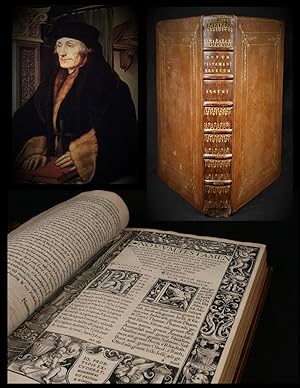
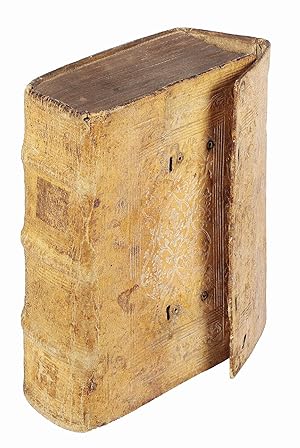
![Seller image for [THE LIVES OF THE FAMOUS PHILOSOPHERS.] . Diogenis Laertij De vitis, decretis, & responsis celebrium philosophorum Libri decem, nunc primum excusi. for sale by Buddenbrooks, Inc.](https://pictures.abebooks.com/inventory/md/md15659537913_5.jpg)
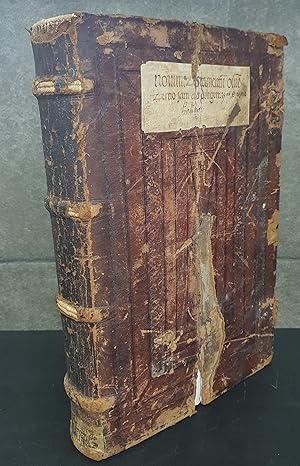
![Seller image for Paraphrases Des. Erasmi Roterodami in epistolas Pauli ad Rhomanos, Corinthios & Galatas . [bound with] . ad Ephesios, Philippenses, & Colossenses, & in duas ad Thessalonicenses. [bound with] ad Timotheum duas, ad Titum unam, & ad Philemonem unam . for sale by James Cummins Bookseller, ABAA](https://pictures.abebooks.com/inventory/md/md10777526598.jpg)
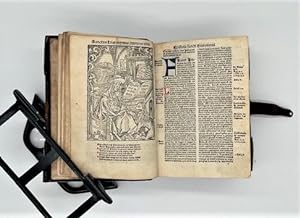
![Seller image for ['Arukh] Dictionarium chaldaicum non ta[m] ad Chaldaicos interpretes q[uam] Rabbinoru[m] intelligenda co[m]mentaria necessarium [.]. for sale by Antiquariat INLIBRIS Gilhofer Nfg. GmbH](https://pictures.abebooks.com/inventory/md/md14578491818.jpg)
![Seller image for [Melechet ha-Dikduk] ????? ??????? Institutiones grammaticae in Hebraeam linguam FR Sebastiani Munsteri Minoritae, Ingelnheimensis, in quibus quid per ordinem tractetur, sequens indicabit pagella. for sale by Bernard Quaritch Ltd ABA ILAB](https://pictures.abebooks.com/inventory/md/md31833471337.jpg)
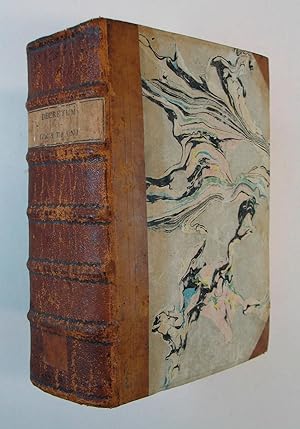
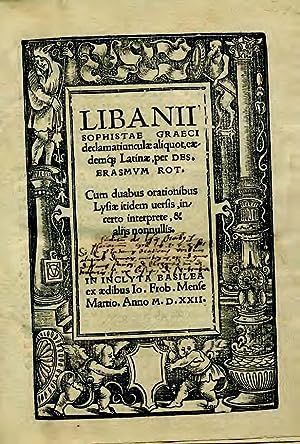
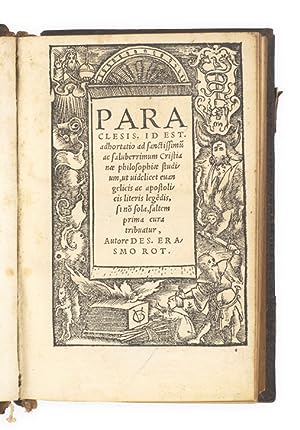
![Seller image for Historia mundi, multo quam antehac unquam prodiit emaculatius [.] annotationibus eruditorum hominum praesertim Hermolai Barbari [ ] additus est index, in quo nihil desideres [ Index in universum naturalis historiae C.Plinii opus, summa diligentia collectus]. for sale by Bernard Quaritch Ltd ABA ILAB](https://pictures.abebooks.com/inventory/md/md31777048010.jpg)
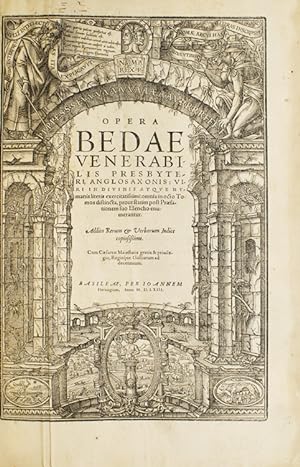

![Seller image for [Mishle Shelomoh ben-David]. Proverbia Salomonis, iam recens iuxta Hebraica[m] veritate[m] translata & annotatio[n]ibus illustrata. for sale by Antiquariat INLIBRIS Gilhofer Nfg. GmbH](https://pictures.abebooks.com/inventory/md/md15401160325.jpg)
![Seller image for Opera. Hrsg. von Erasmus von Roterdam. [Mitgebunden:] ATHANASIUS, Hl., Patriarch von Alexandrien. Opera, studiosius quam antea fuerint Eiusdem Athanasii de variis quaestionibus liber. His interpretibus Christophoro Porsena. Ambrosio monacho. Angelo Politiano. Ioanne Capnione. Accessit praeterea operi, Erasmi Roterodami Paraclesis, ipsiusque Athanasii vita. Titel innerhalb breiter Holzschnitt-Bordüre von Ambrosius Holbein. for sale by Biblion Antiquariat](https://pictures.abebooks.com/inventory/md/md762045265.jpg)

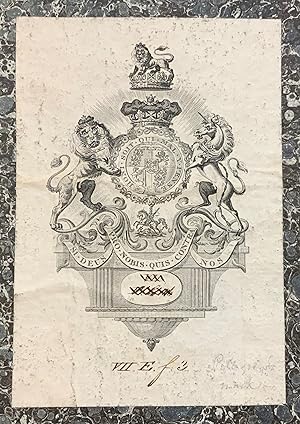
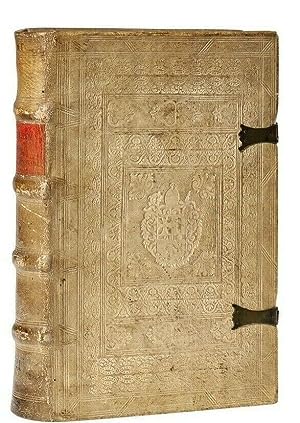
![Seller image for HISTORICI CLARISSIMI OPUS LUCULENTIUS elimatiusque editum [etc.]. for sale by LIBRAIRIE ÉRIC CASTÉRAN](https://pictures.abebooks.com/inventory/md/md7966358119.jpg)
![Seller image for Kalendarium Hebraicum, opera Sebastiani Munsteri ex Hebraeorum penetralibus iam recens in lucem aeditum. Hokhmat ha-mazalot bi-tekufot u-me'ubarot ve-ha-kevo'ot. [Text hebräisch und lateinisch]. Mit Holzschnitten im Text und auf zwei Falttafeln sowie illustrierten Initialen. for sale by Versandantiquariat Bürck (VDA / ILAB)](https://pictures.abebooks.com/inventory/md/md22660932844.jpg)
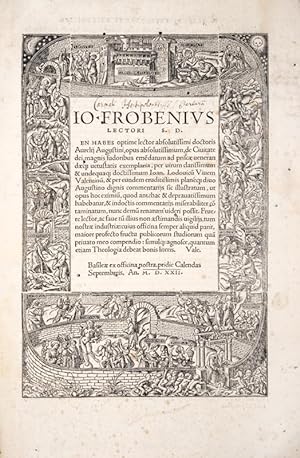
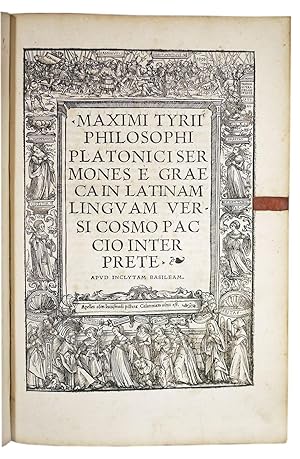
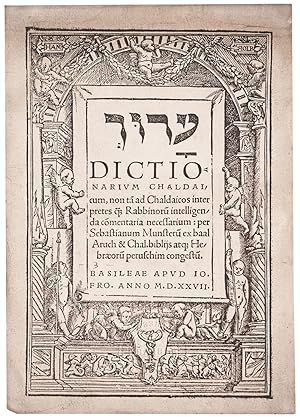
![Seller image for AESOPI PHRYGIS FABULAE GRAECE ET LATINE [Bound With] GALEOMYOMACHIA, HOCEST, FELIUM & MURIUM PUGNA for sale by Second Story Books, ABAA](https://pictures.abebooks.com/inventory/md/md30745849341.jpg)
![Seller image for [Omnia Quotquot extant Opera] OMNIA QVOTQVOT EXTANT DIVI AMBROSII EPISCOPI MEDIOLANENSIS OPERA CVM PER DES. ERASMVM ROTERODAMVM. TVM per alios eruditos uiros, accurata diuersorum codioum collatione nunc de/ nuo emendata, in quinque digesta ordines. quorum Primus habet mores, Secundus pugnas aduersus haereticos, Tertius orationes, epistolas, & cõciones || ad populum. Quartue & Quintus explanationes uoluminum Veteris & Novi testamenti unà cum Indice rerun copiosissimo. for sale by Antiquariat Michael Solder](https://pictures.abebooks.com/inventory/md/md30908276944.jpg)
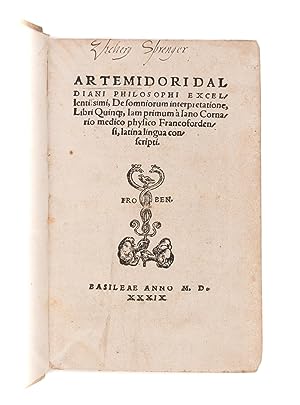
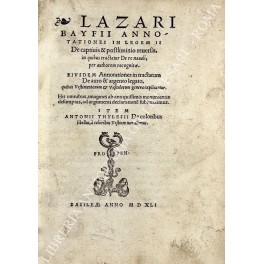
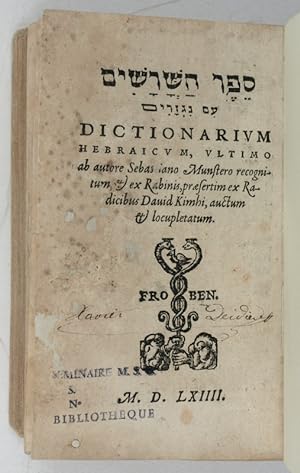
![Seller image for Aseret had-devarim 'im pêrûs. Decalogus praeceptorum divinorum [.] unde iuventus non tam in Hebraismo qum pietate proficere poterit. for sale by Antiquariat INLIBRIS Gilhofer Nfg. GmbH](https://pictures.abebooks.com/inventory/md/md14578491809.jpg)
![Seller image for Pirke Eliyahu [.]. Capitula cantici, specierum, proprietatum, & officiorum. for sale by Antiquariat INLIBRIS Gilhofer Nfg. GmbH](https://pictures.abebooks.com/inventory/md/md14578491811.jpg)
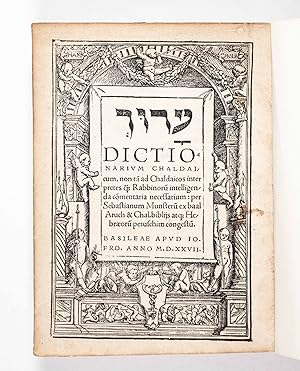
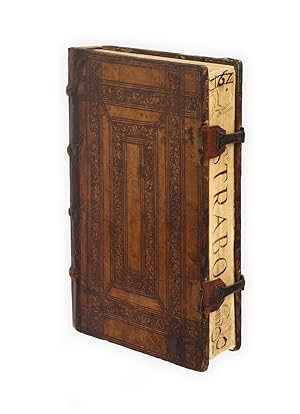
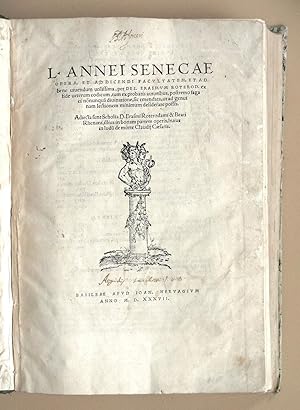
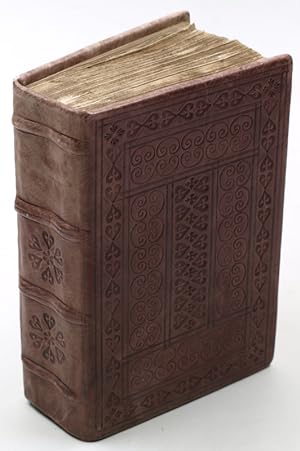
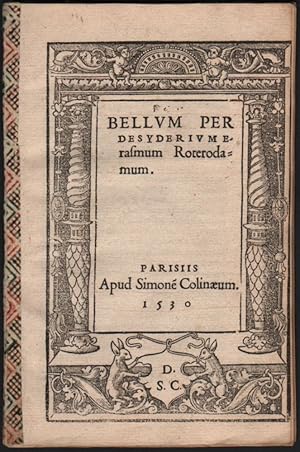
![Seller image for Opera.[with] Opus eruditissimum [ ] in quinque libros digestum. for sale by Sokol Books Ltd. ABA ILAB](https://pictures.abebooks.com/inventory/md/md30763063606.jpg)
![Seller image for De sestertio, talentis, pecuniis, ponderibus, me[n]suris, stipendiis militaribus antiquis [.]. for sale by Antiquariat INLIBRIS Gilhofer Nfg. GmbH](https://pictures.abebooks.com/inventory/md/md19238149019.jpg)
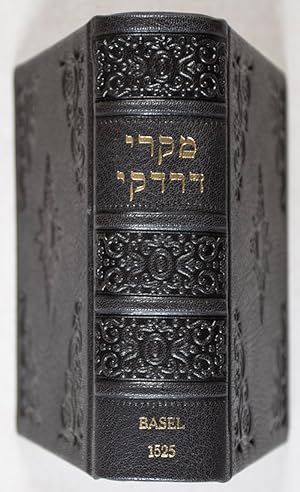
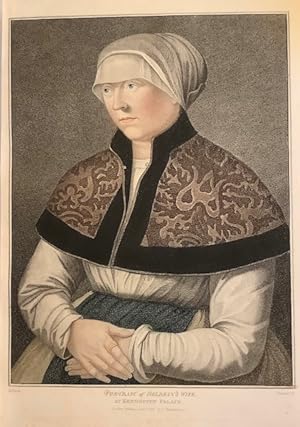
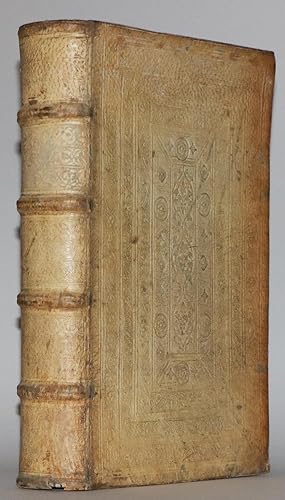
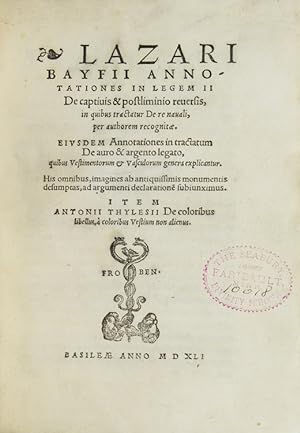
![Seller image for [COMEDIES] Aristophanus K?m?diai Ennea Meta Scholi?n Poll?n Palai?n Kai Pany ?phelim?n : Aristophanis Comoediae Novem Cvm Commentariis Antiqvis Admodum utilibus for sale by Librairie Le Feu Follet](https://pictures.abebooks.com/inventory/md/md31811843494.jpg)